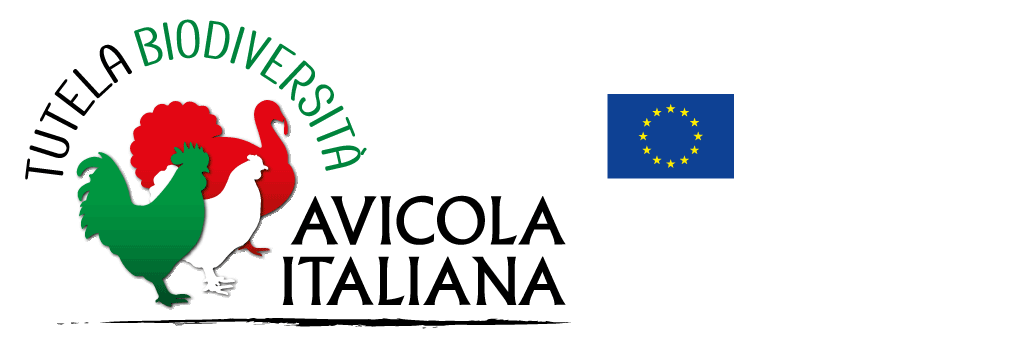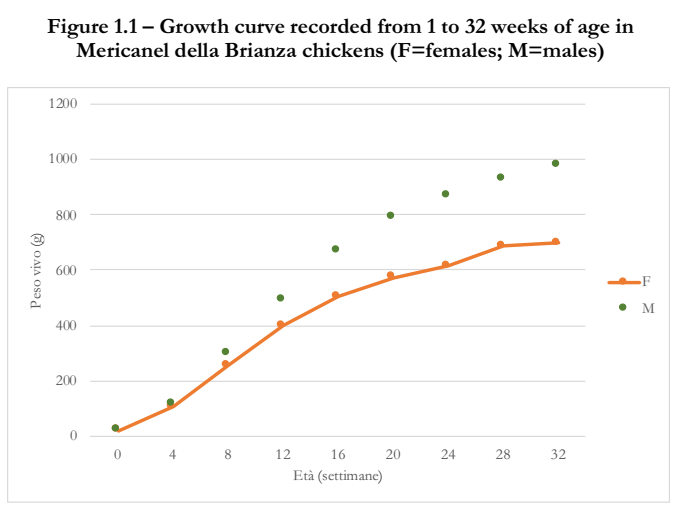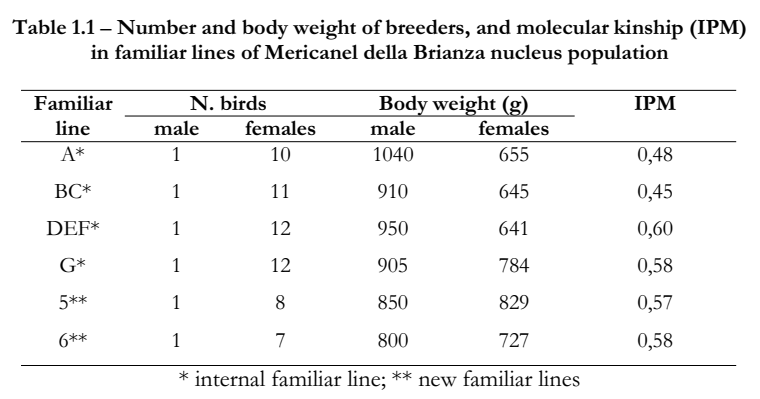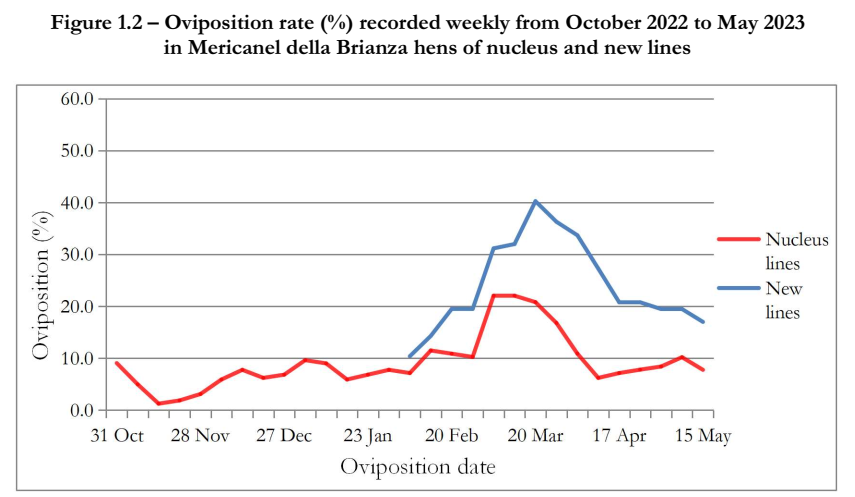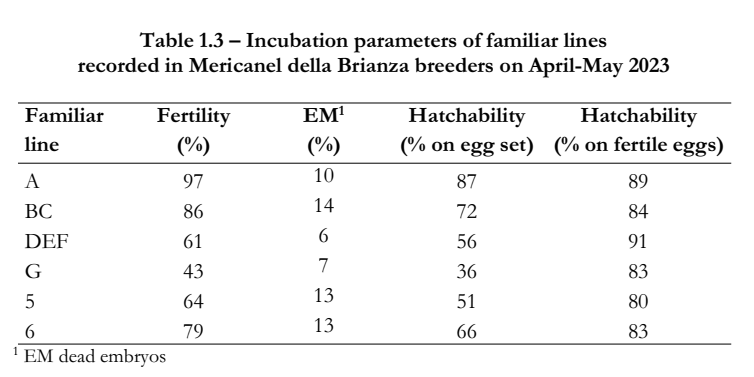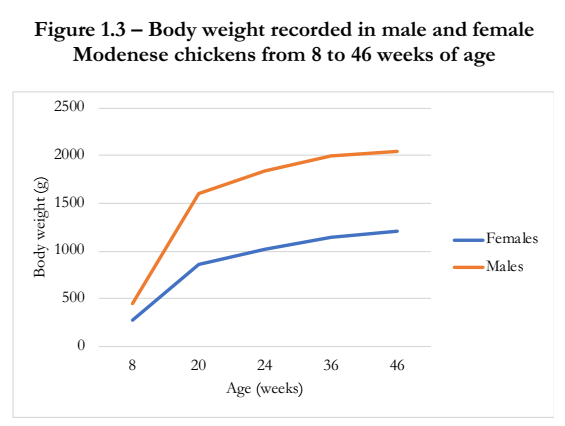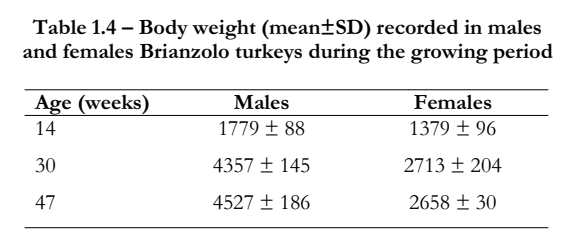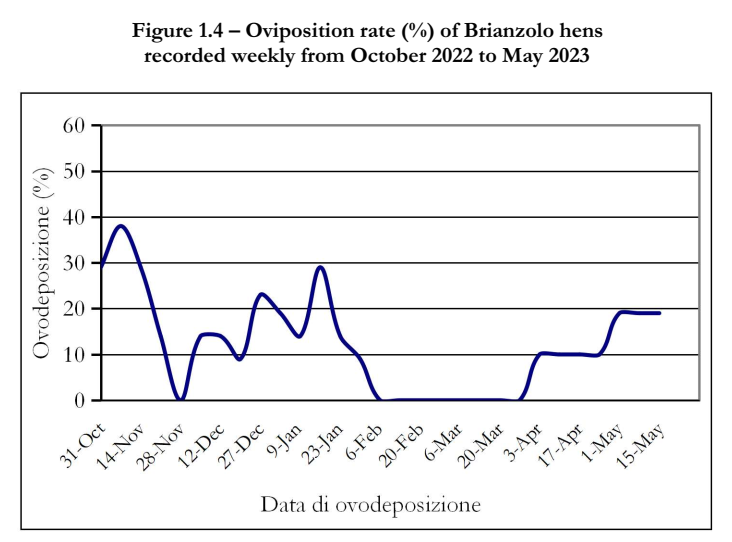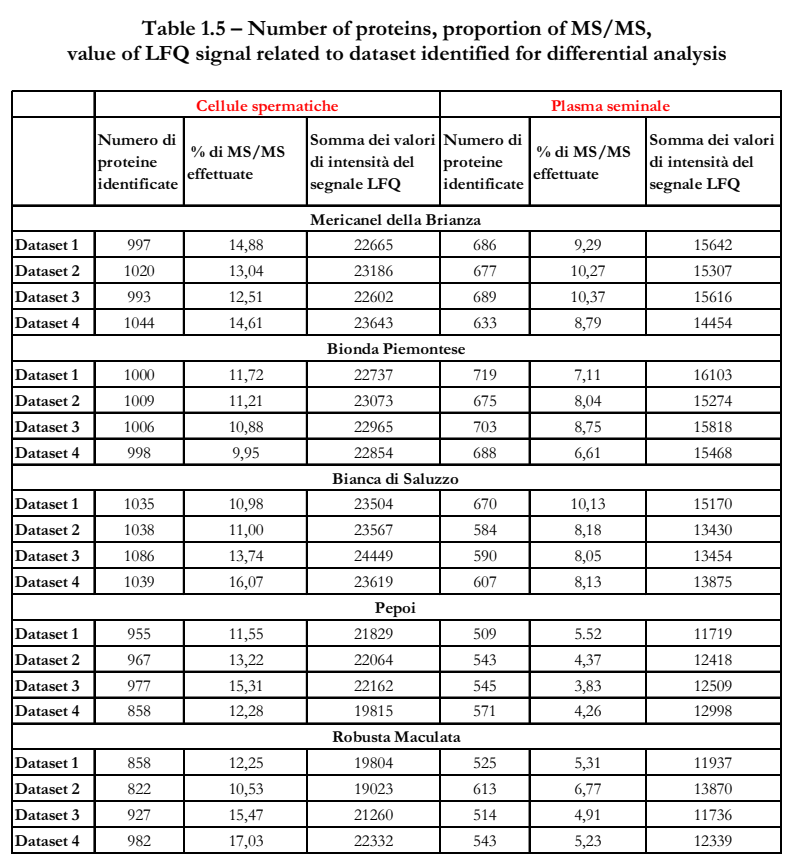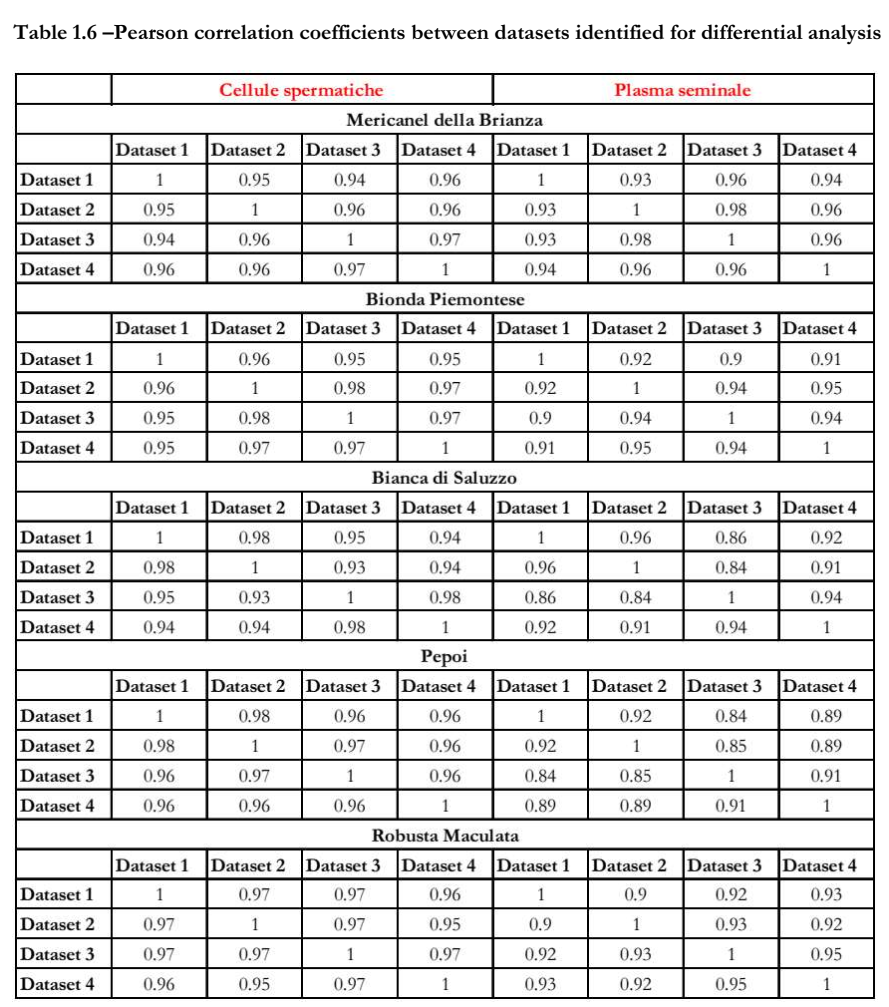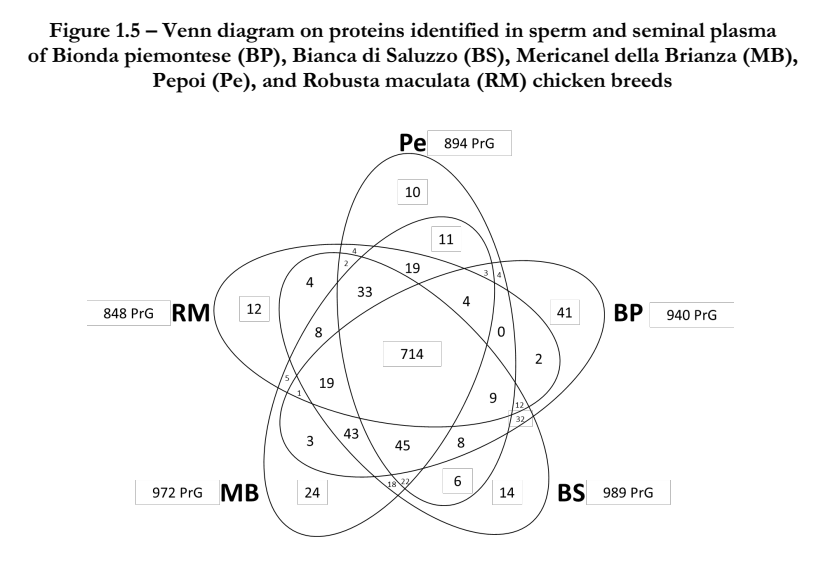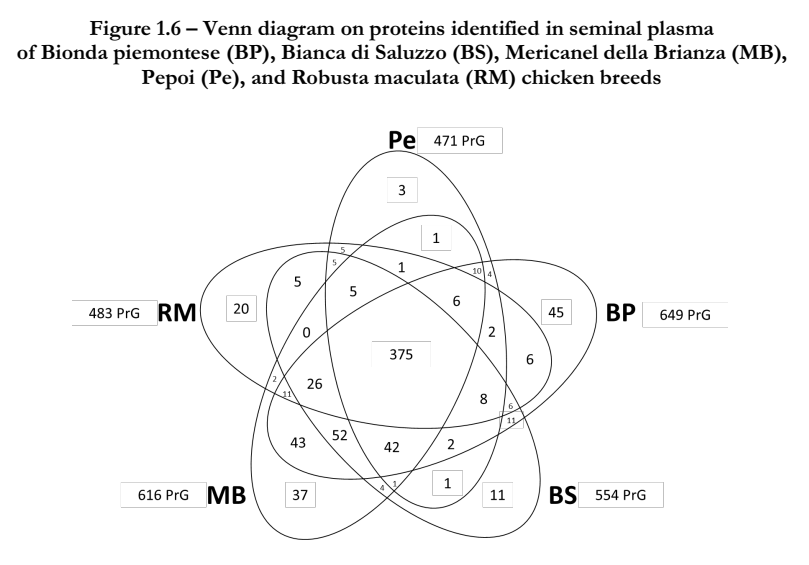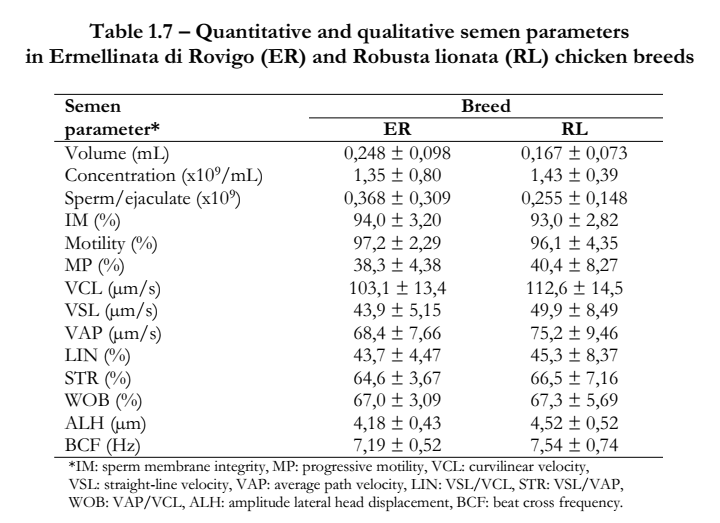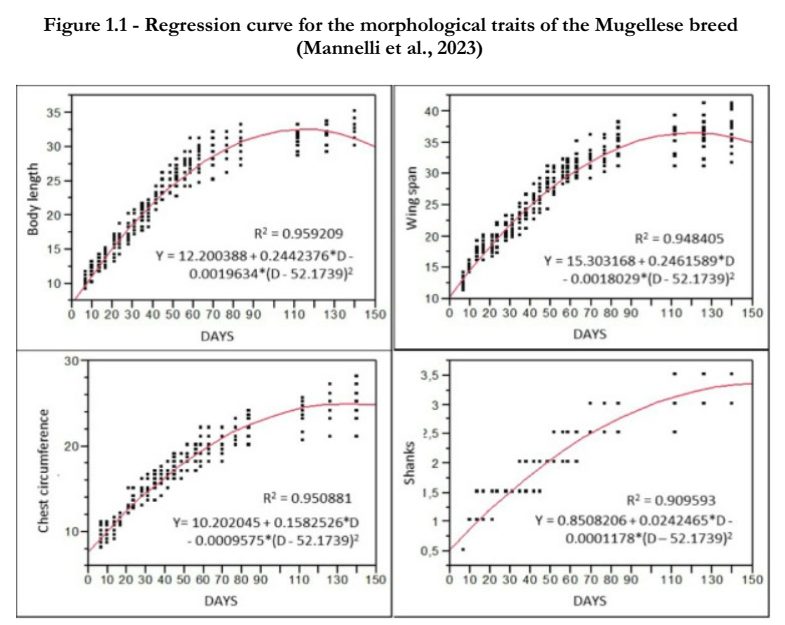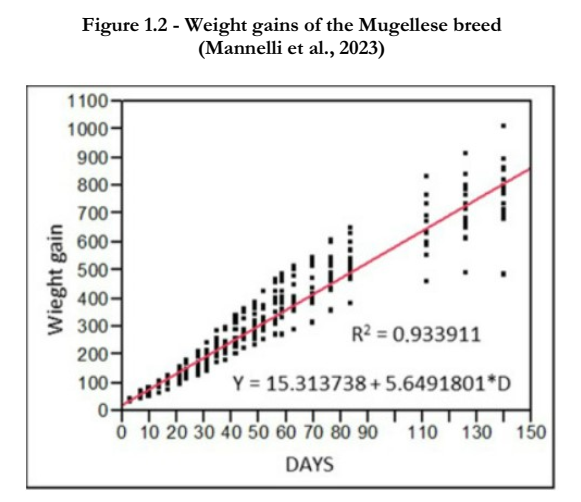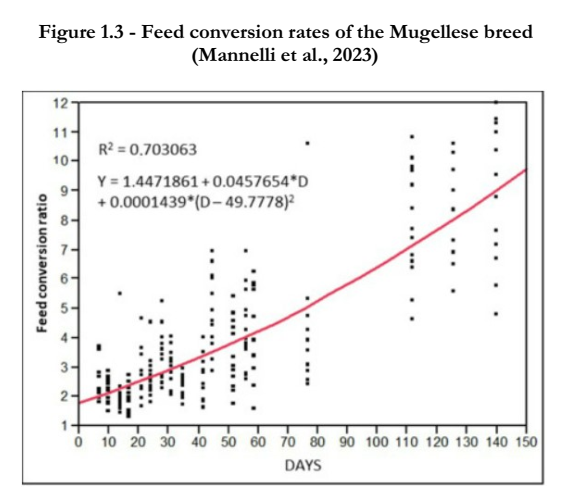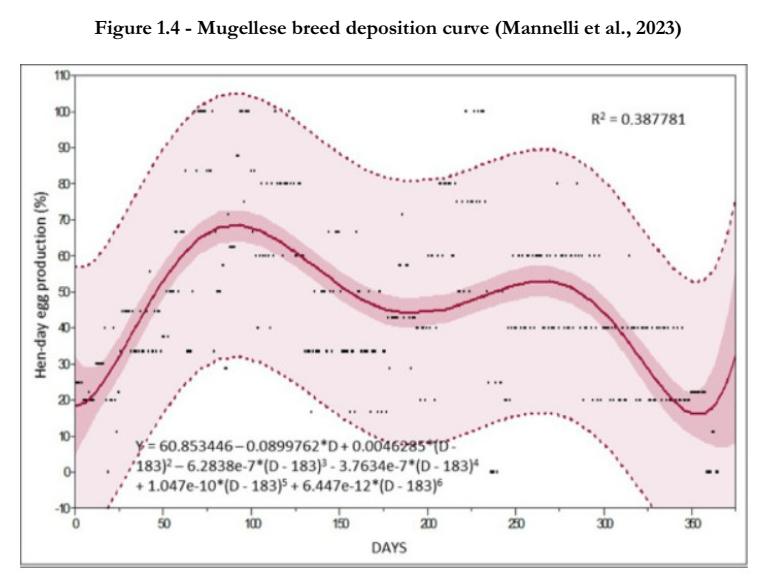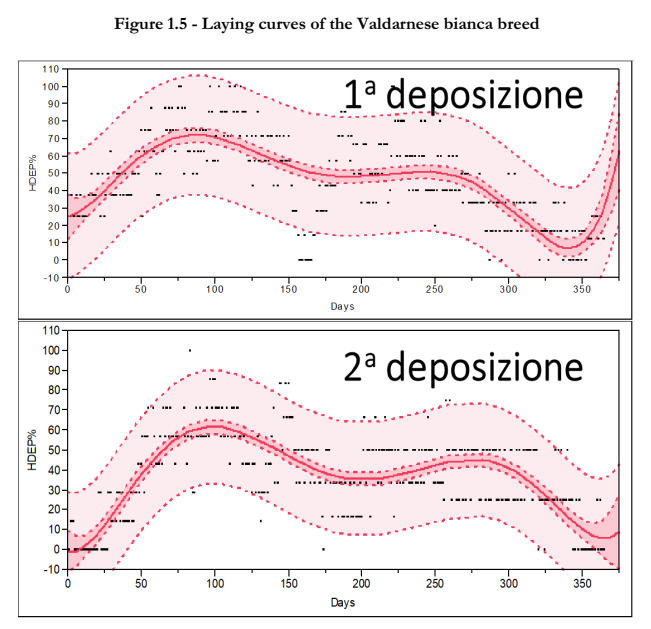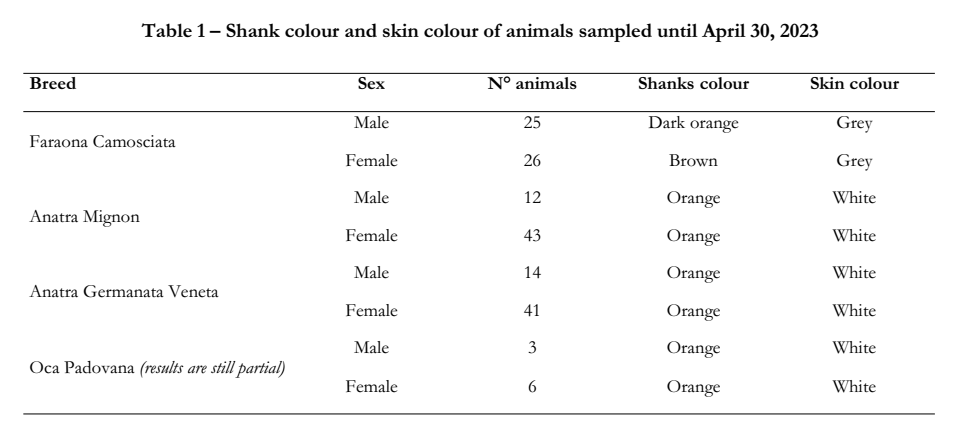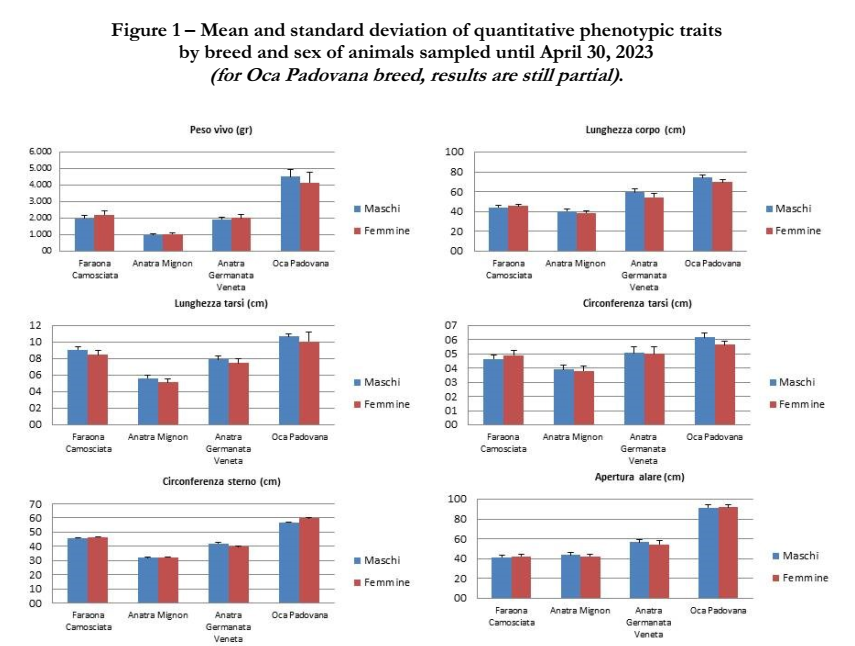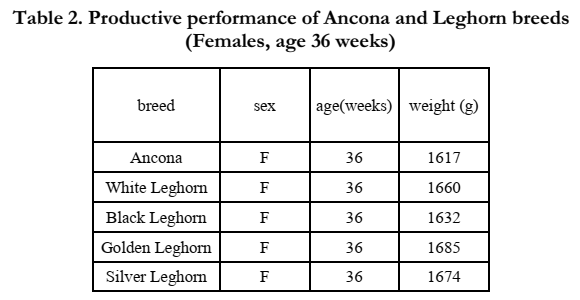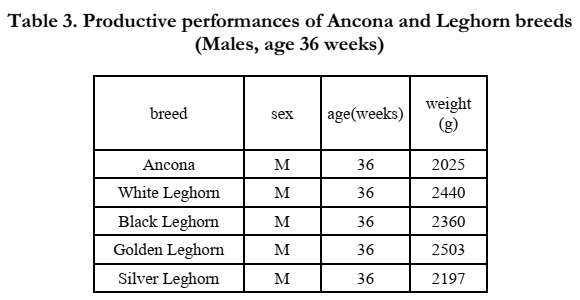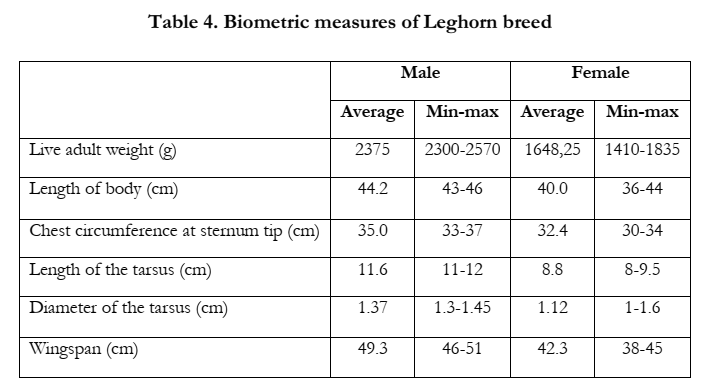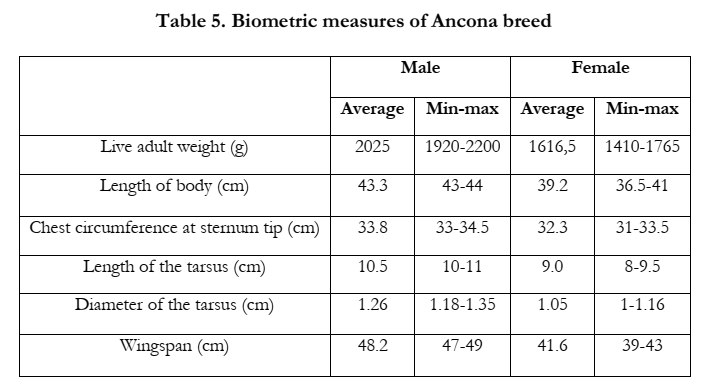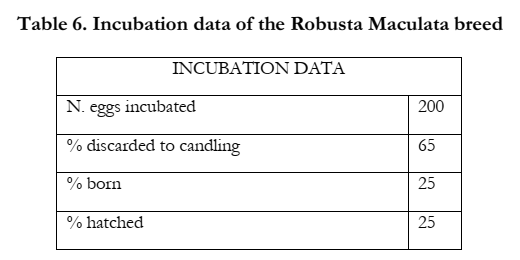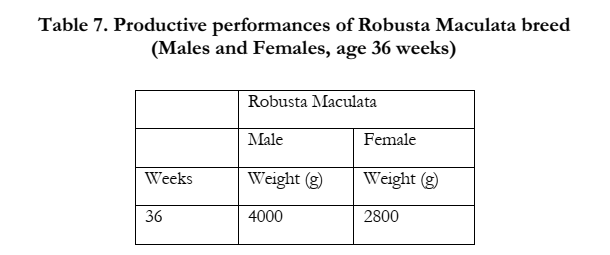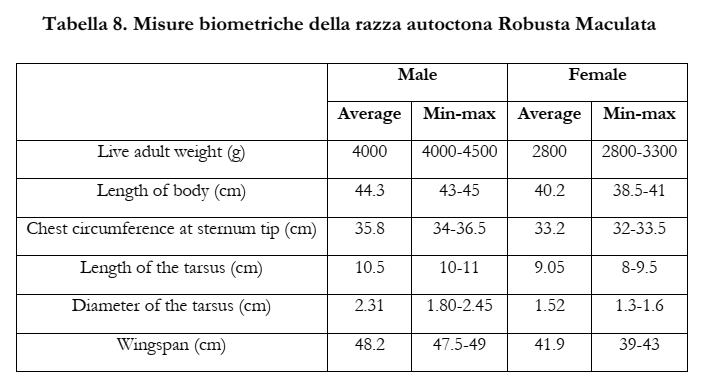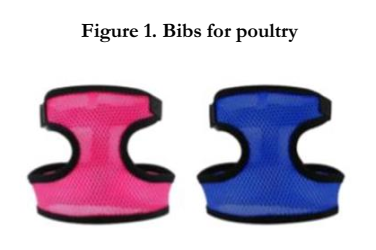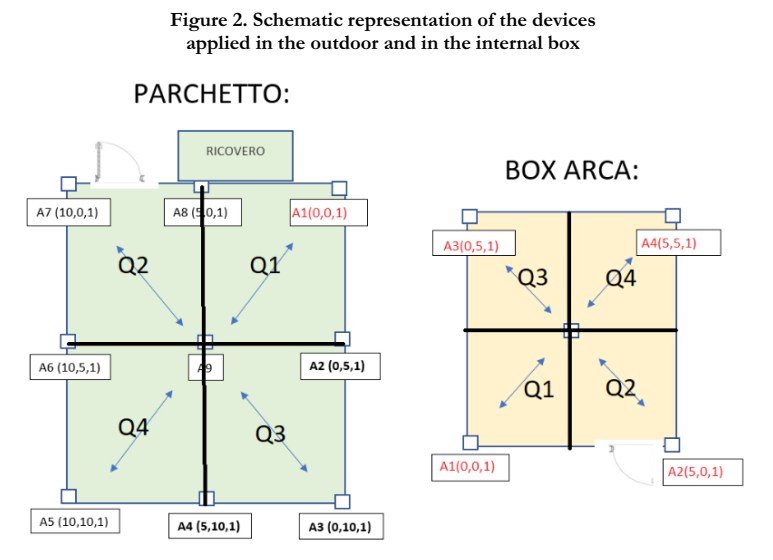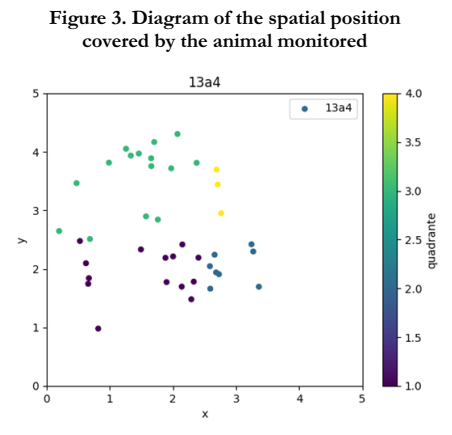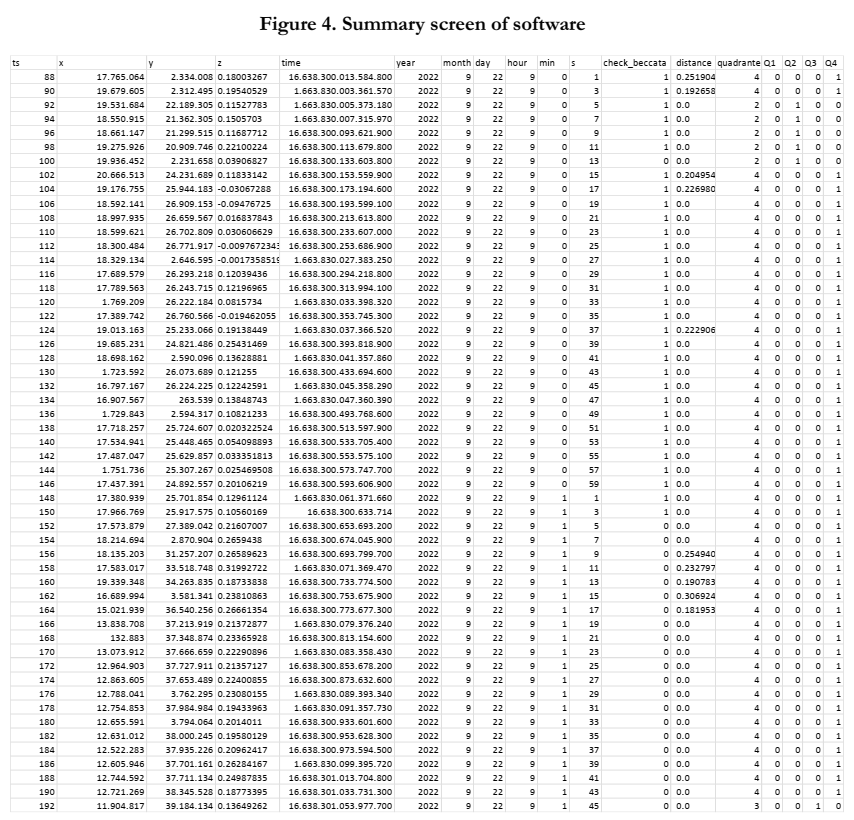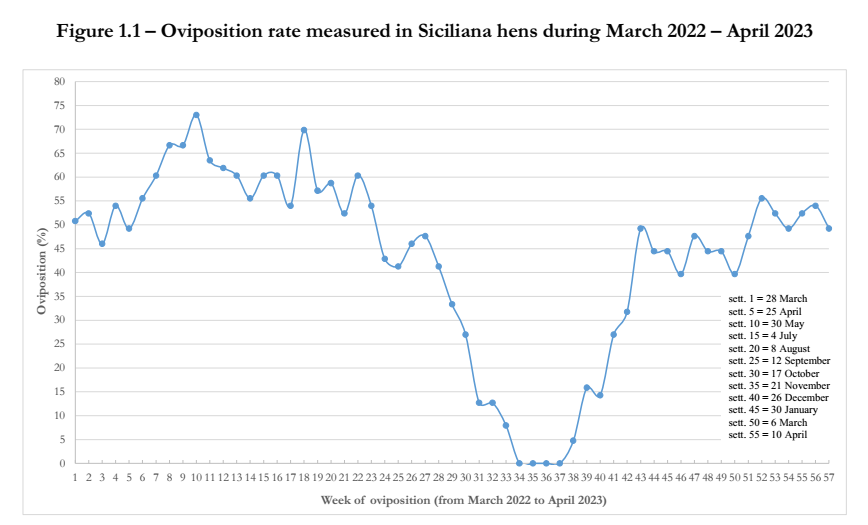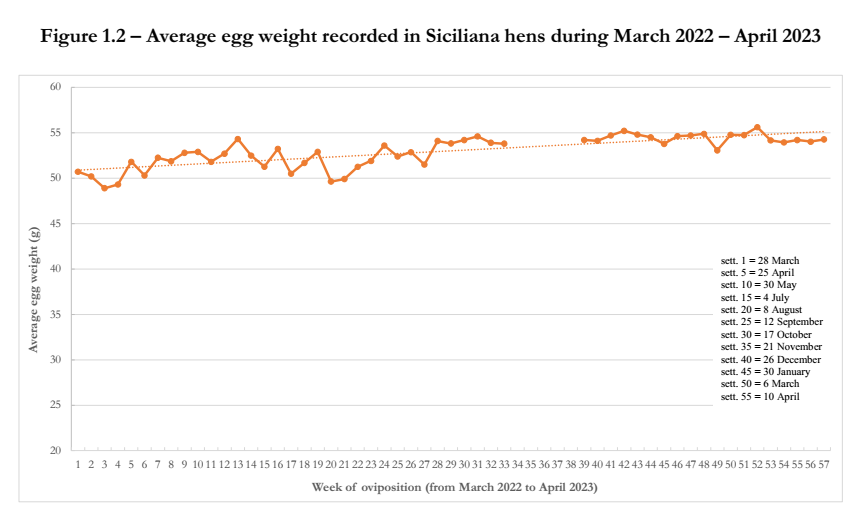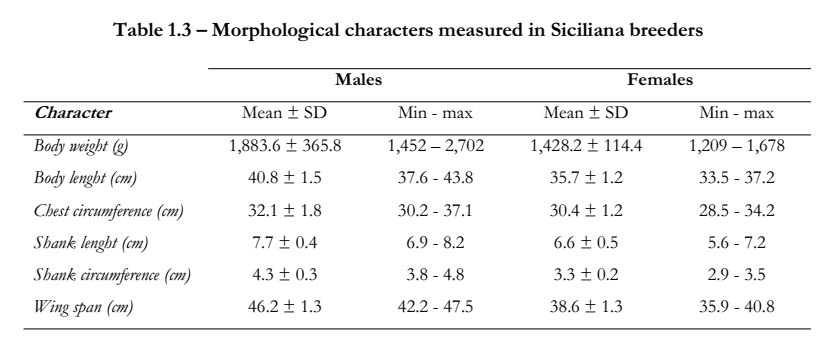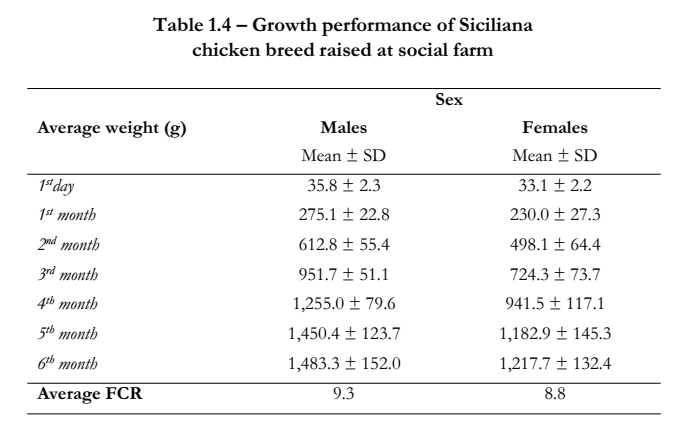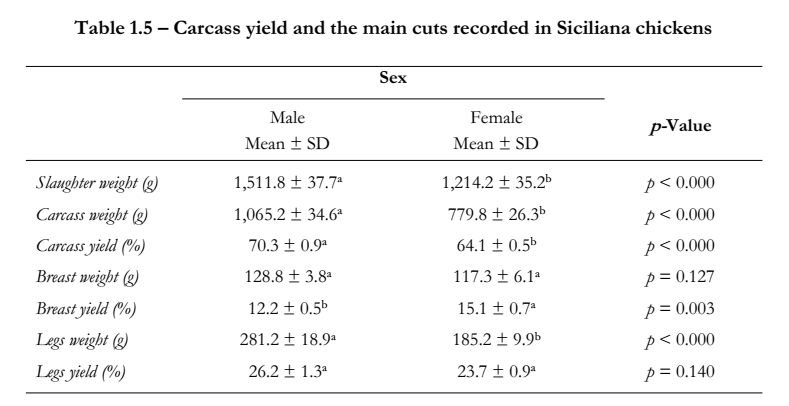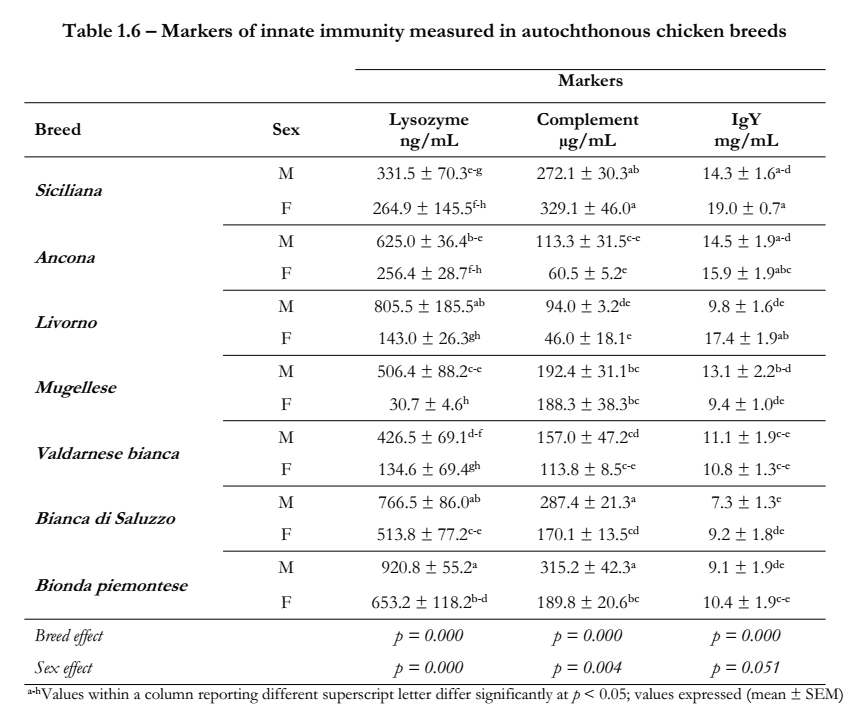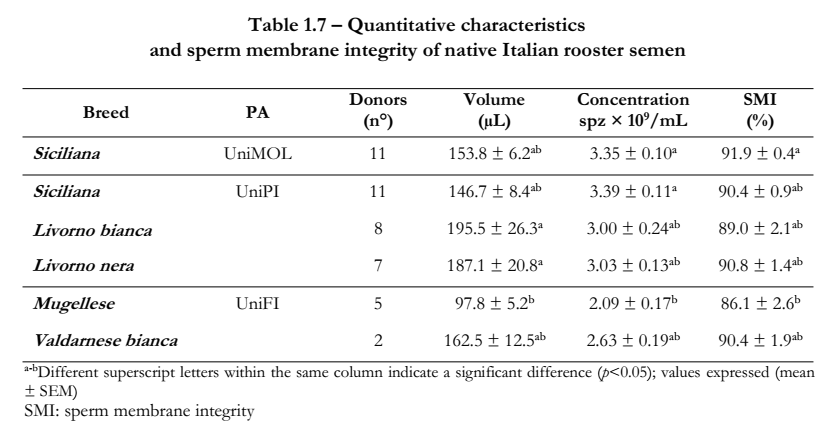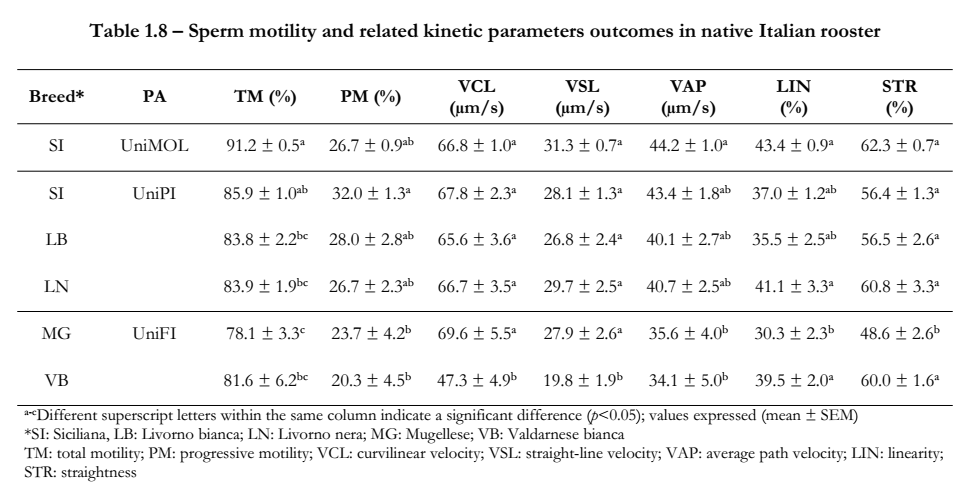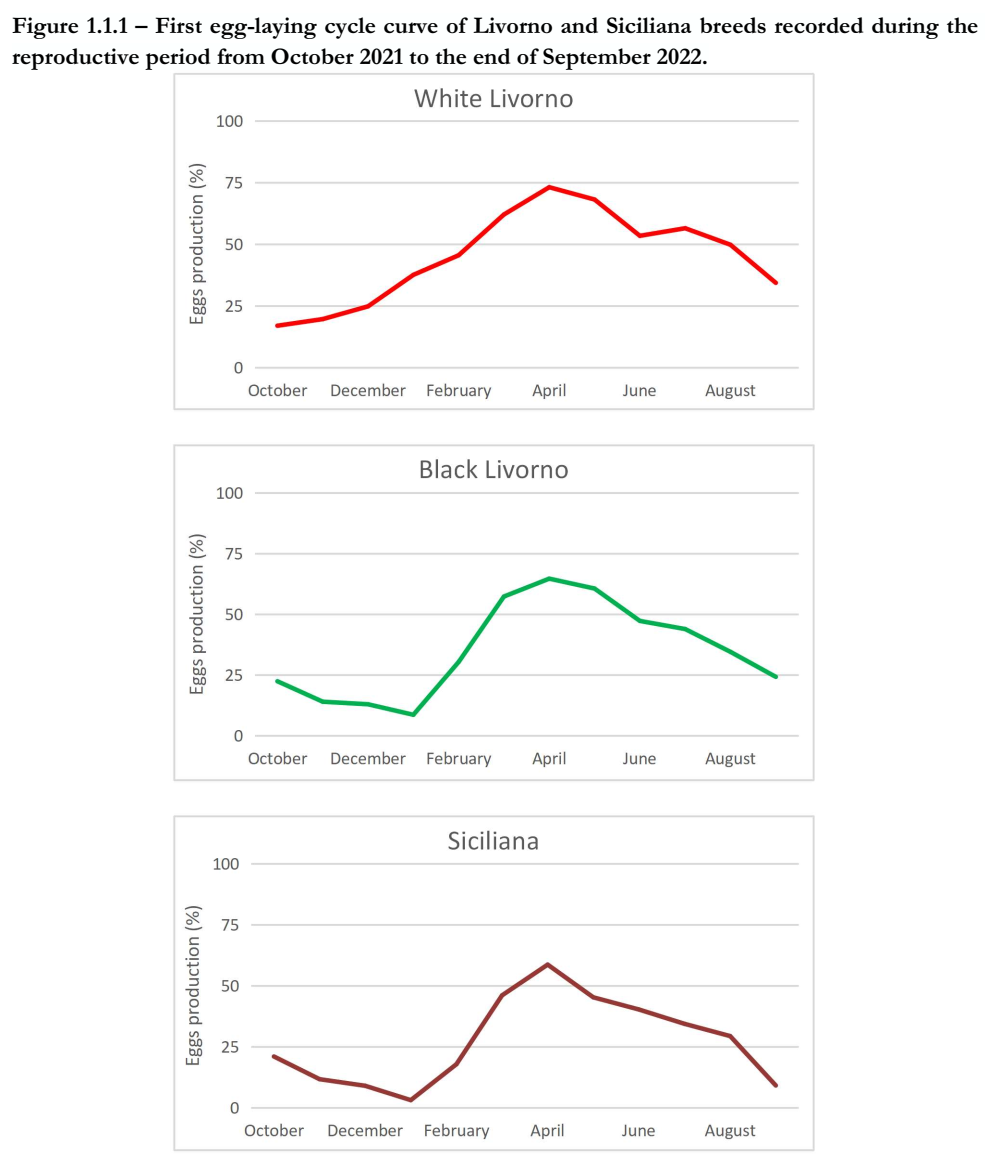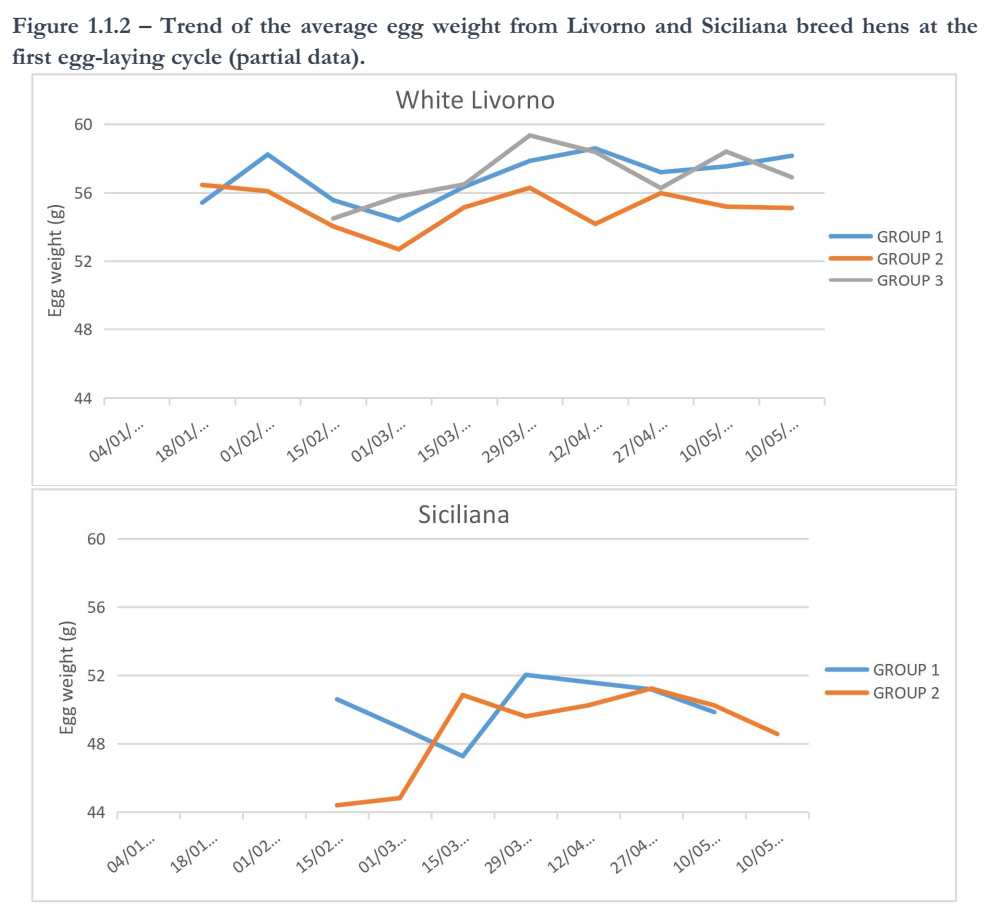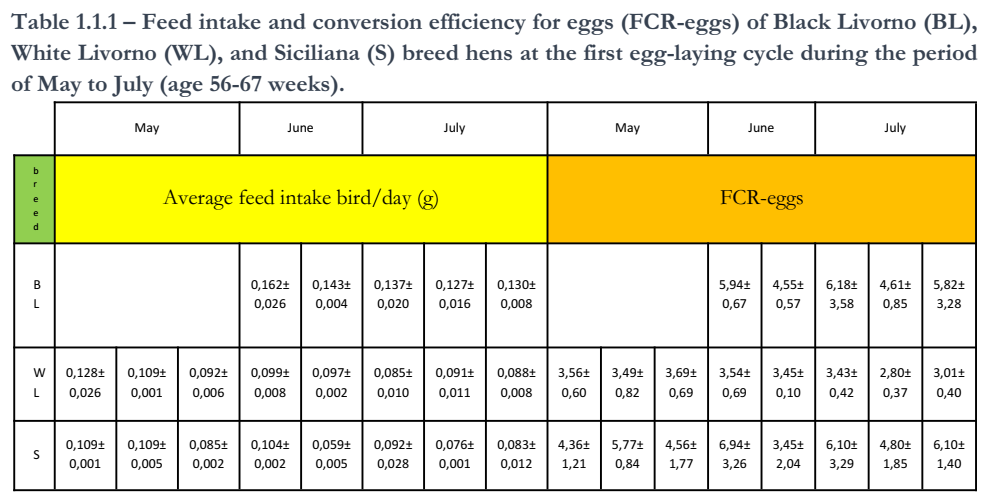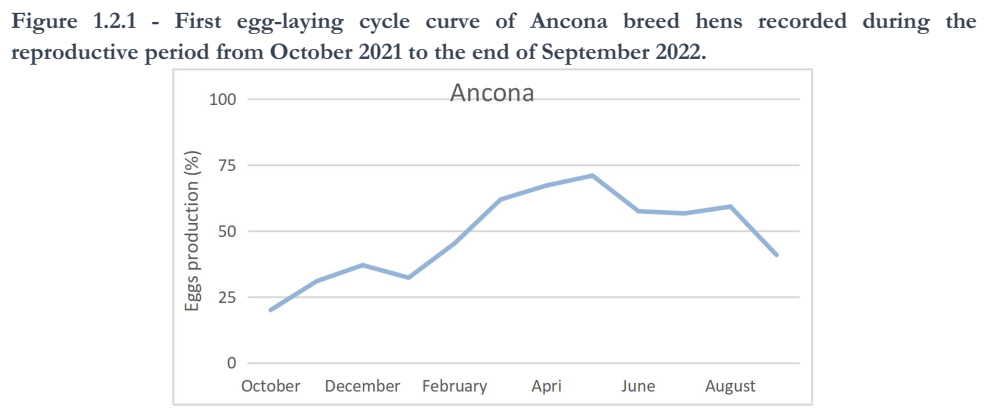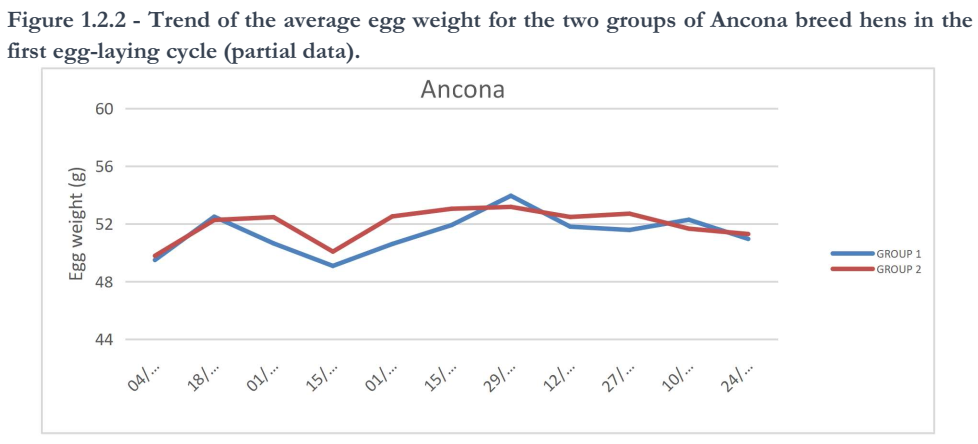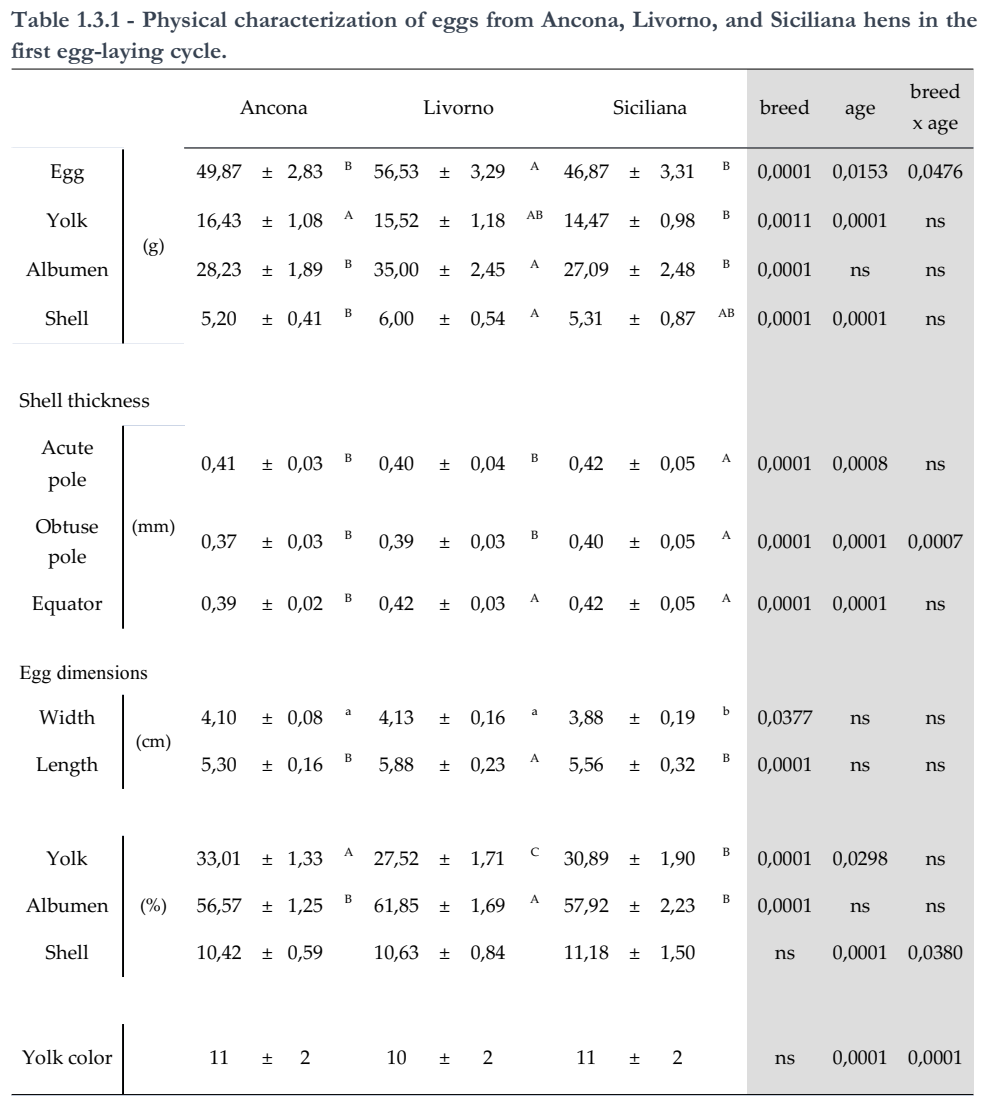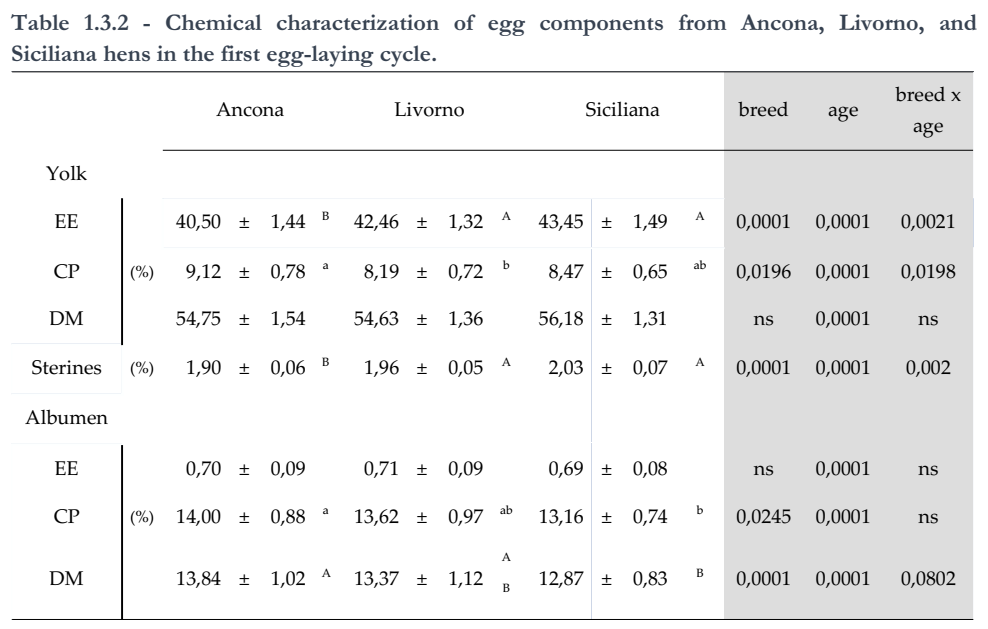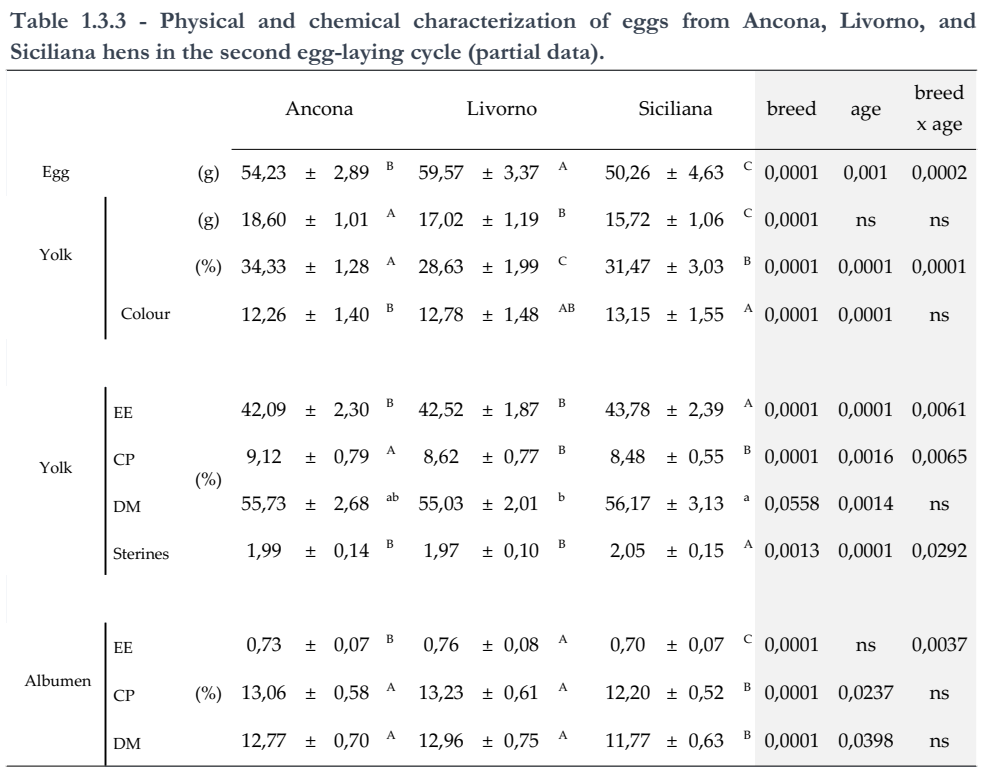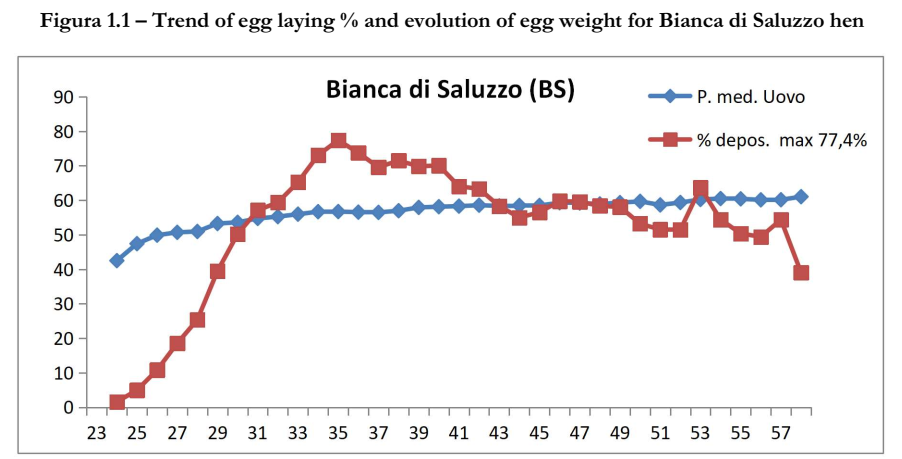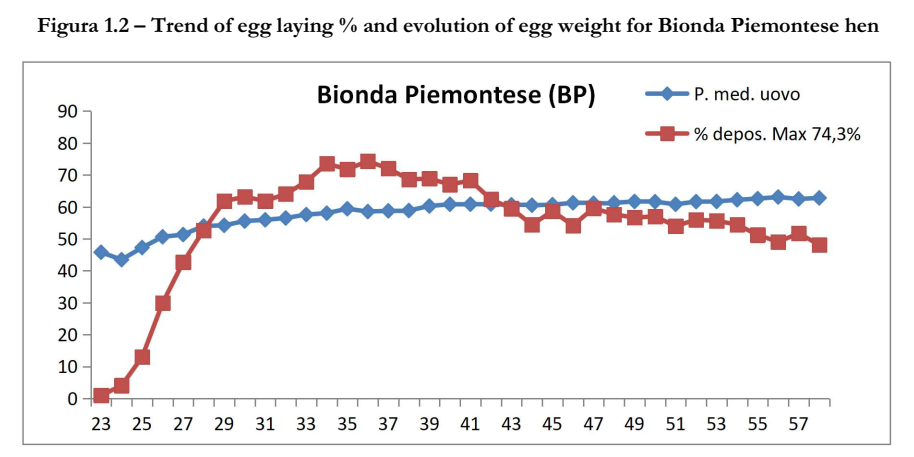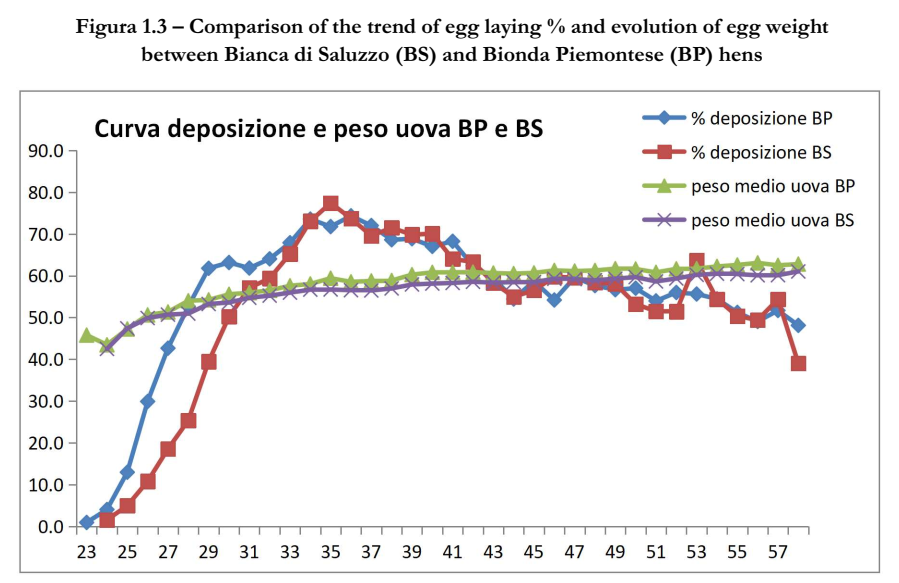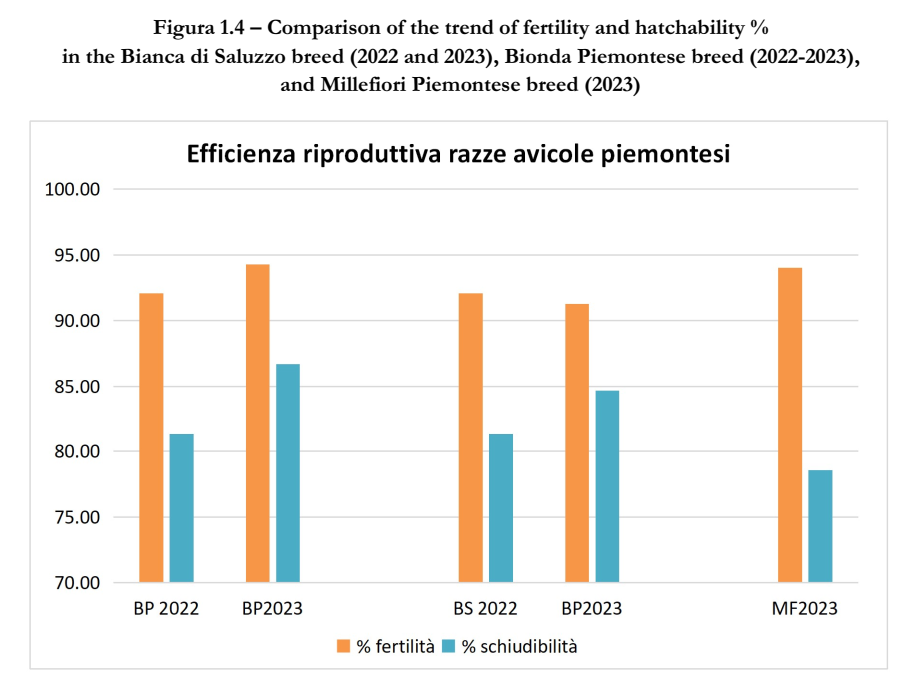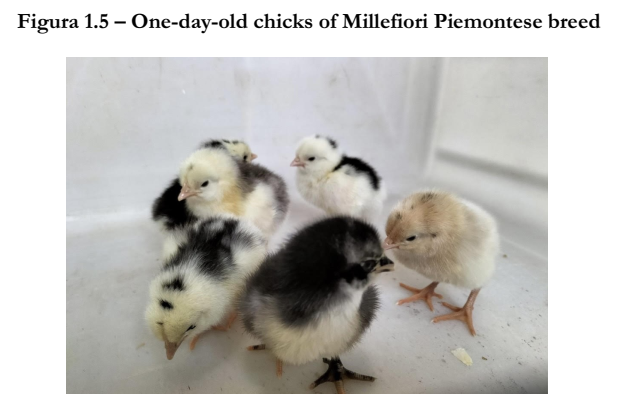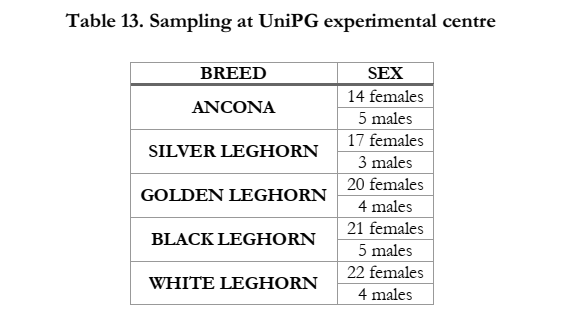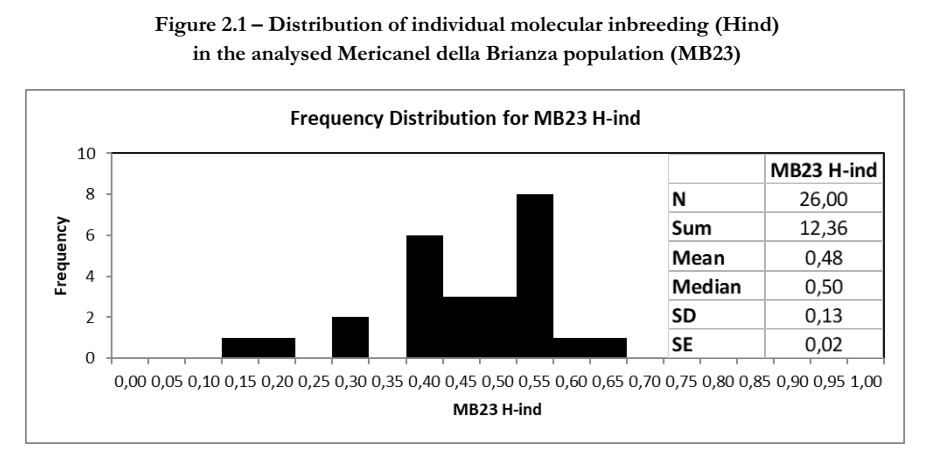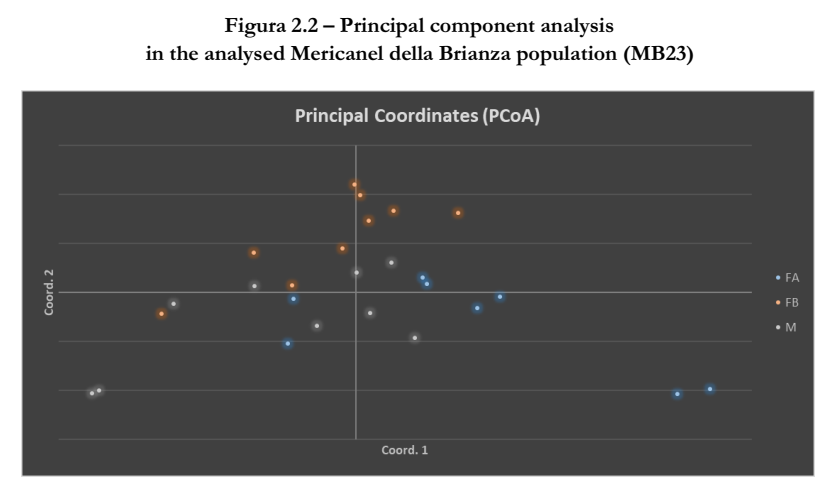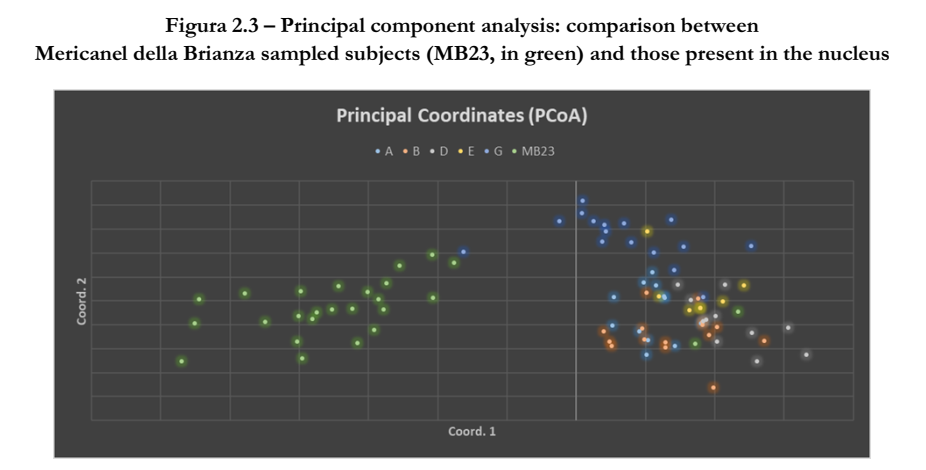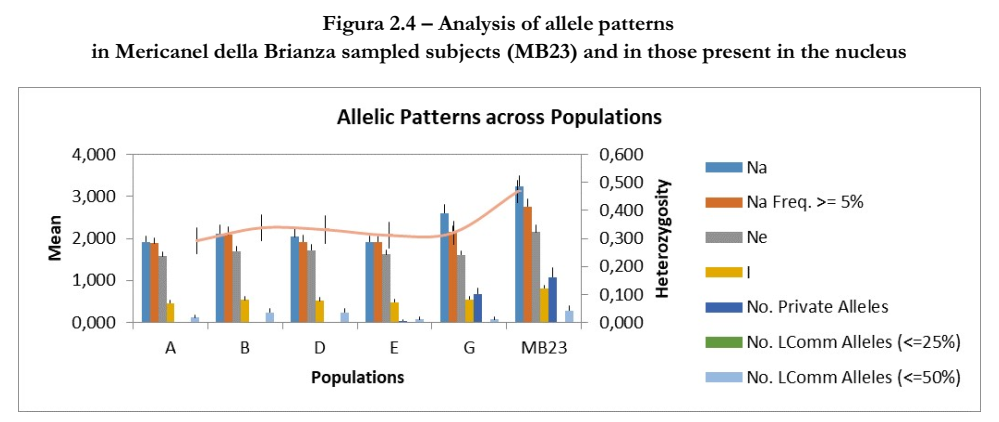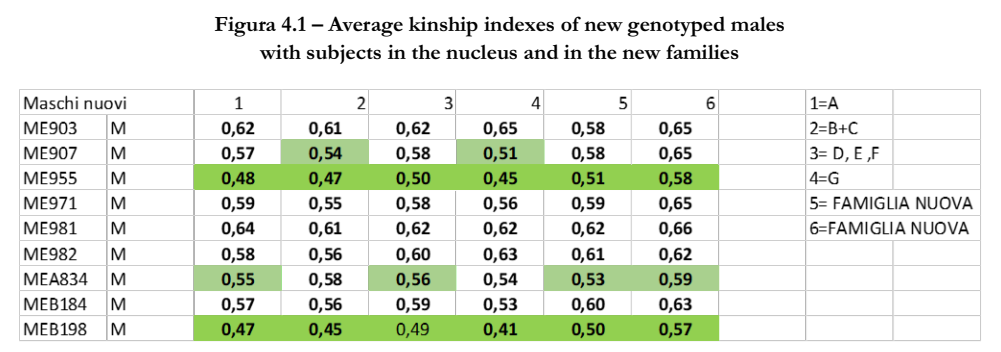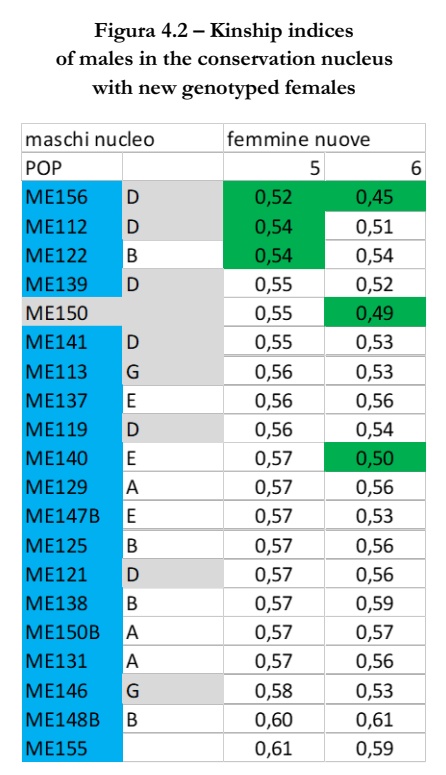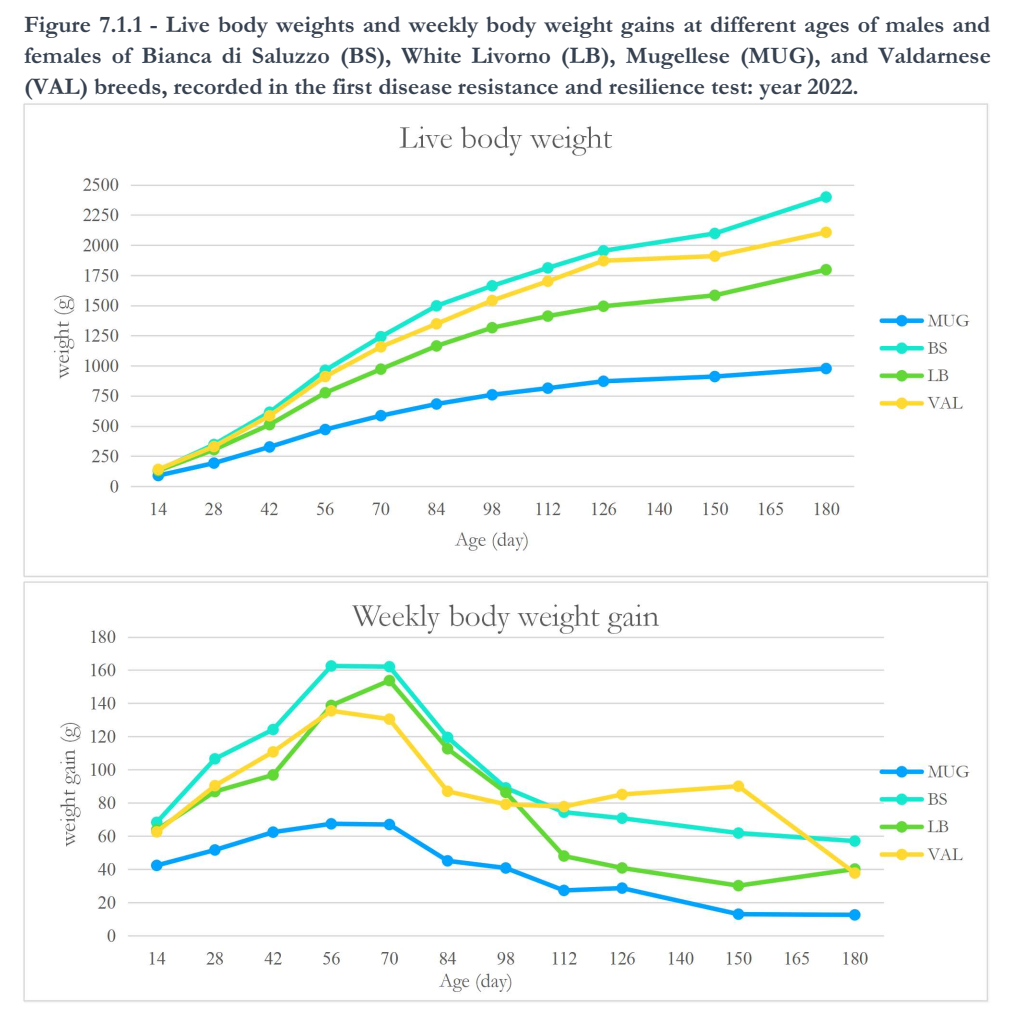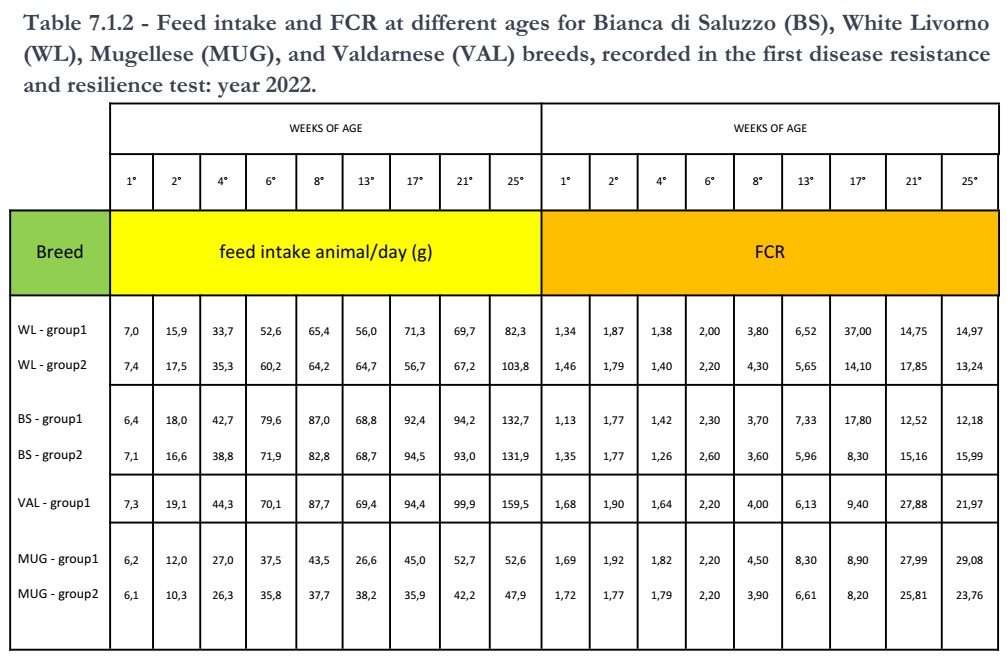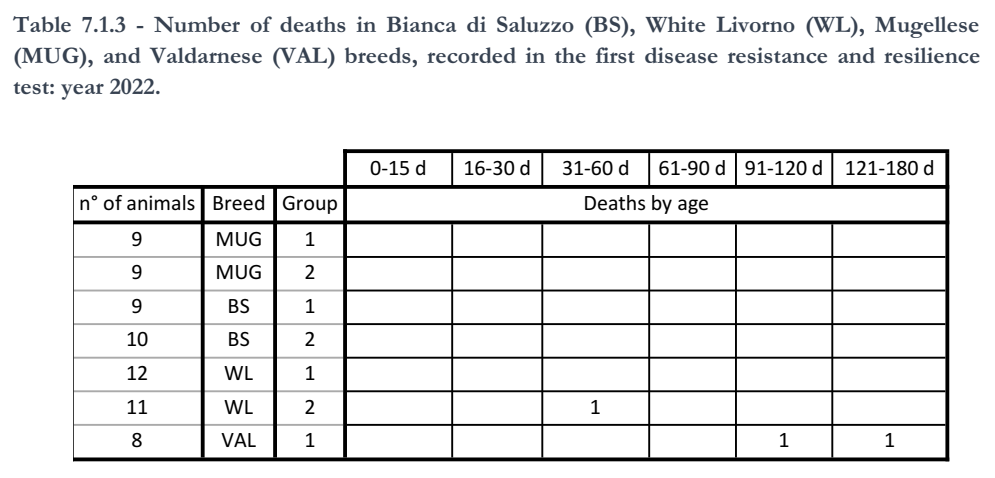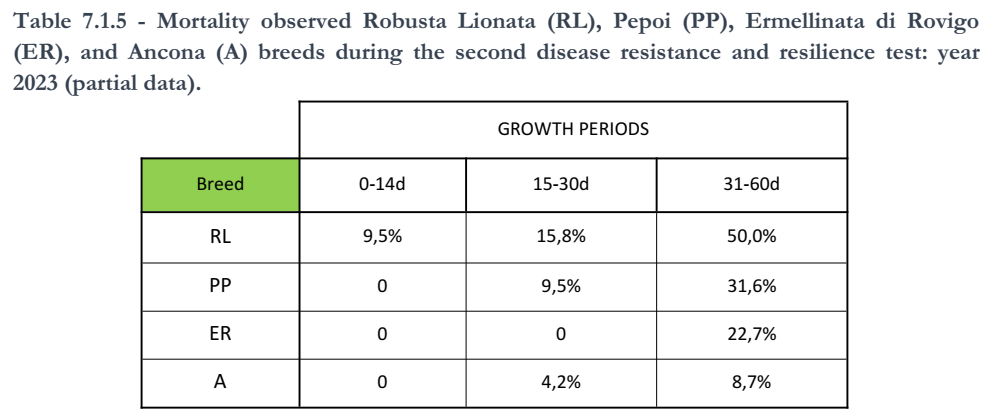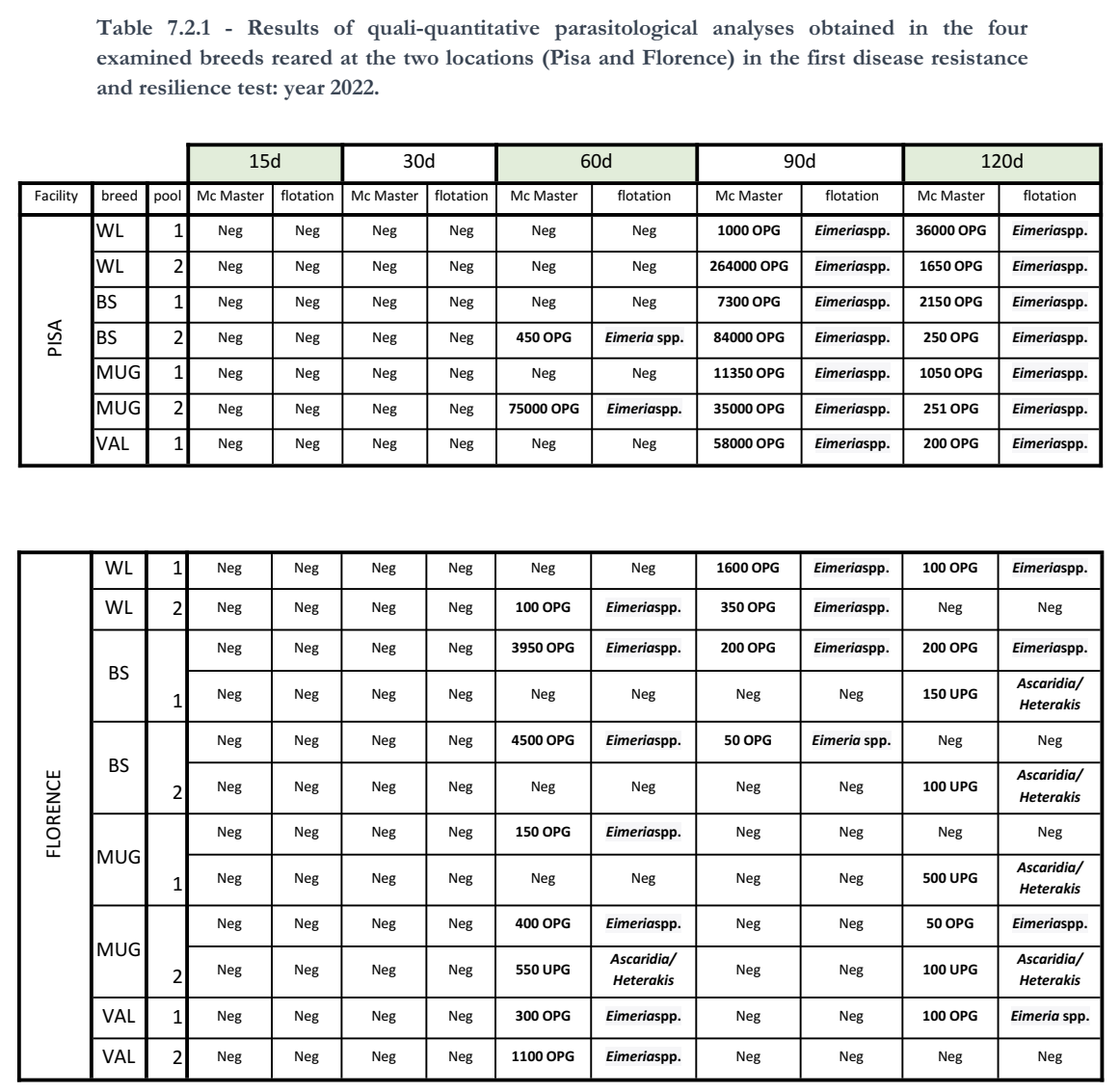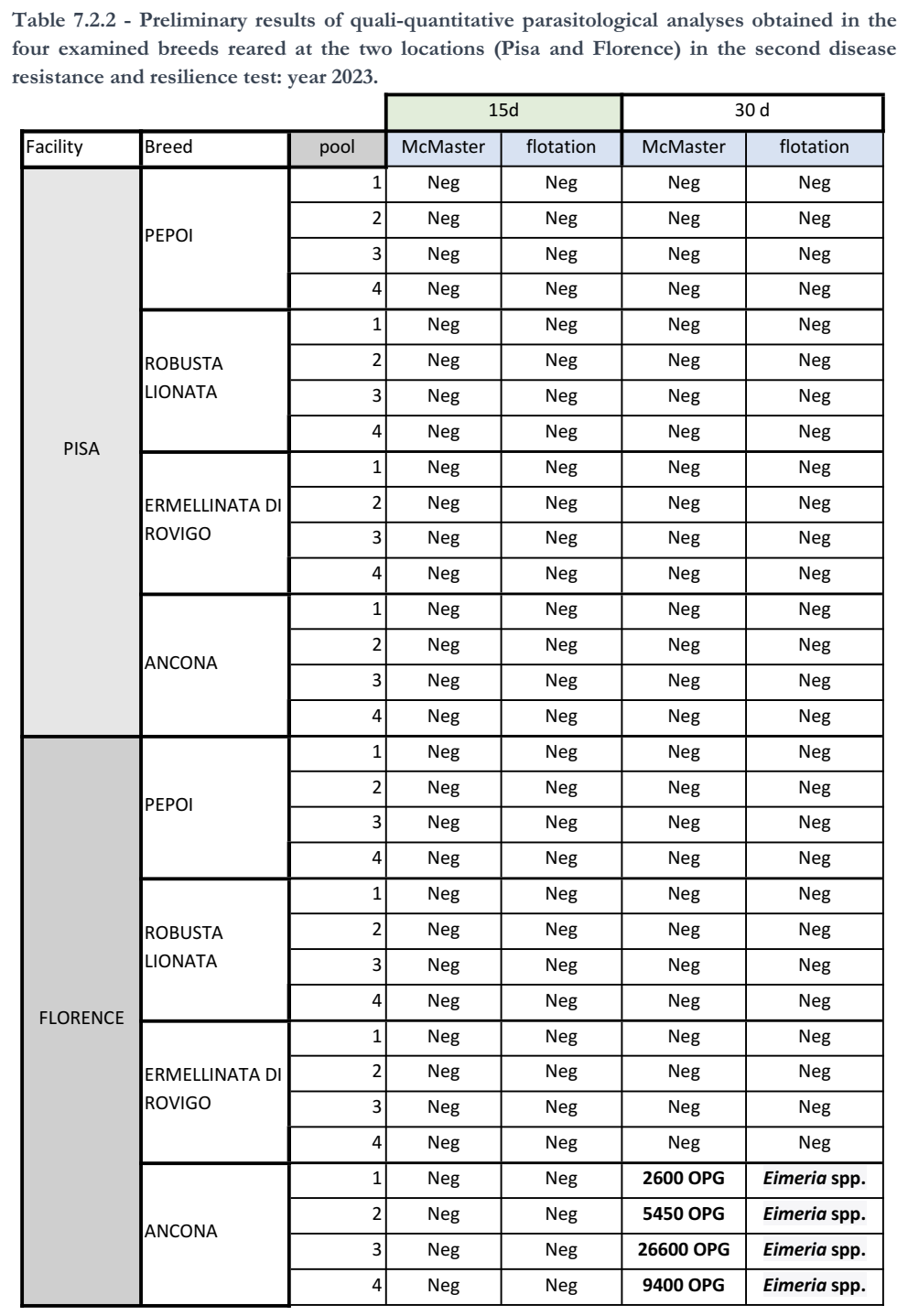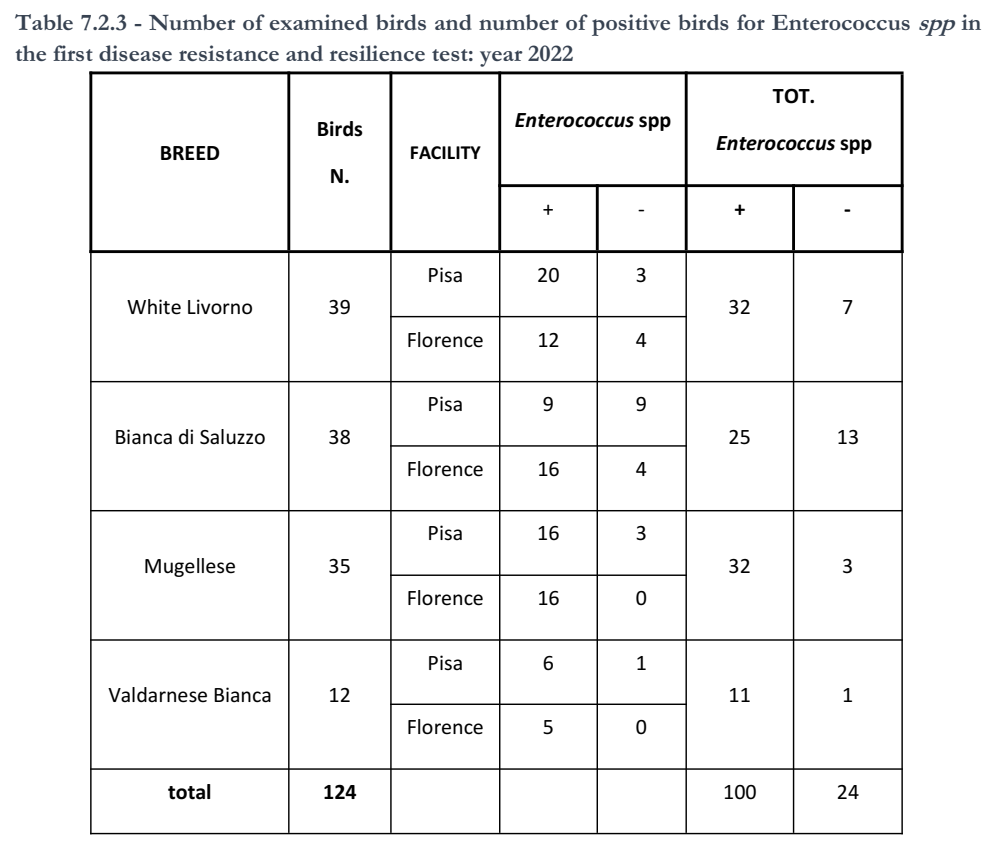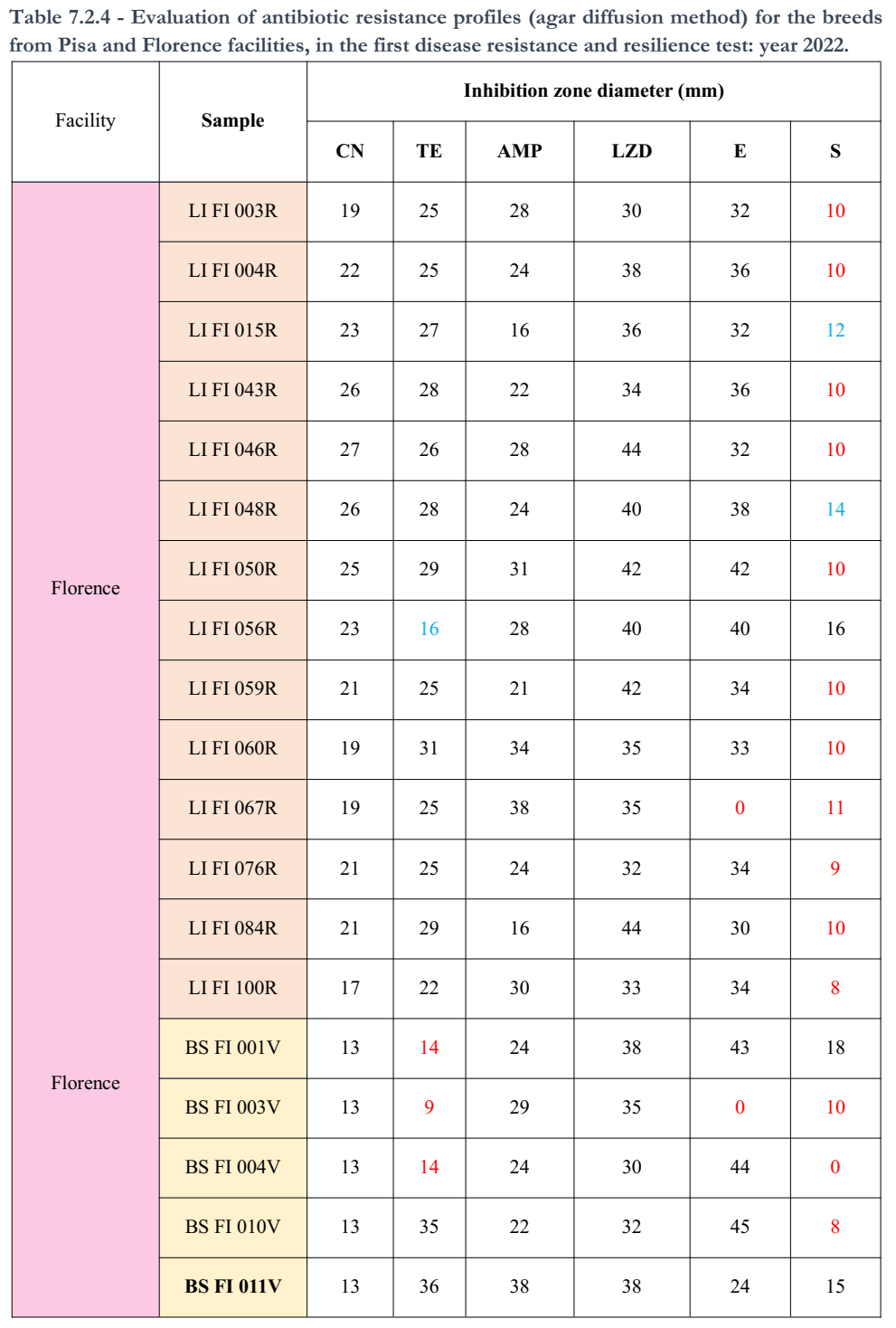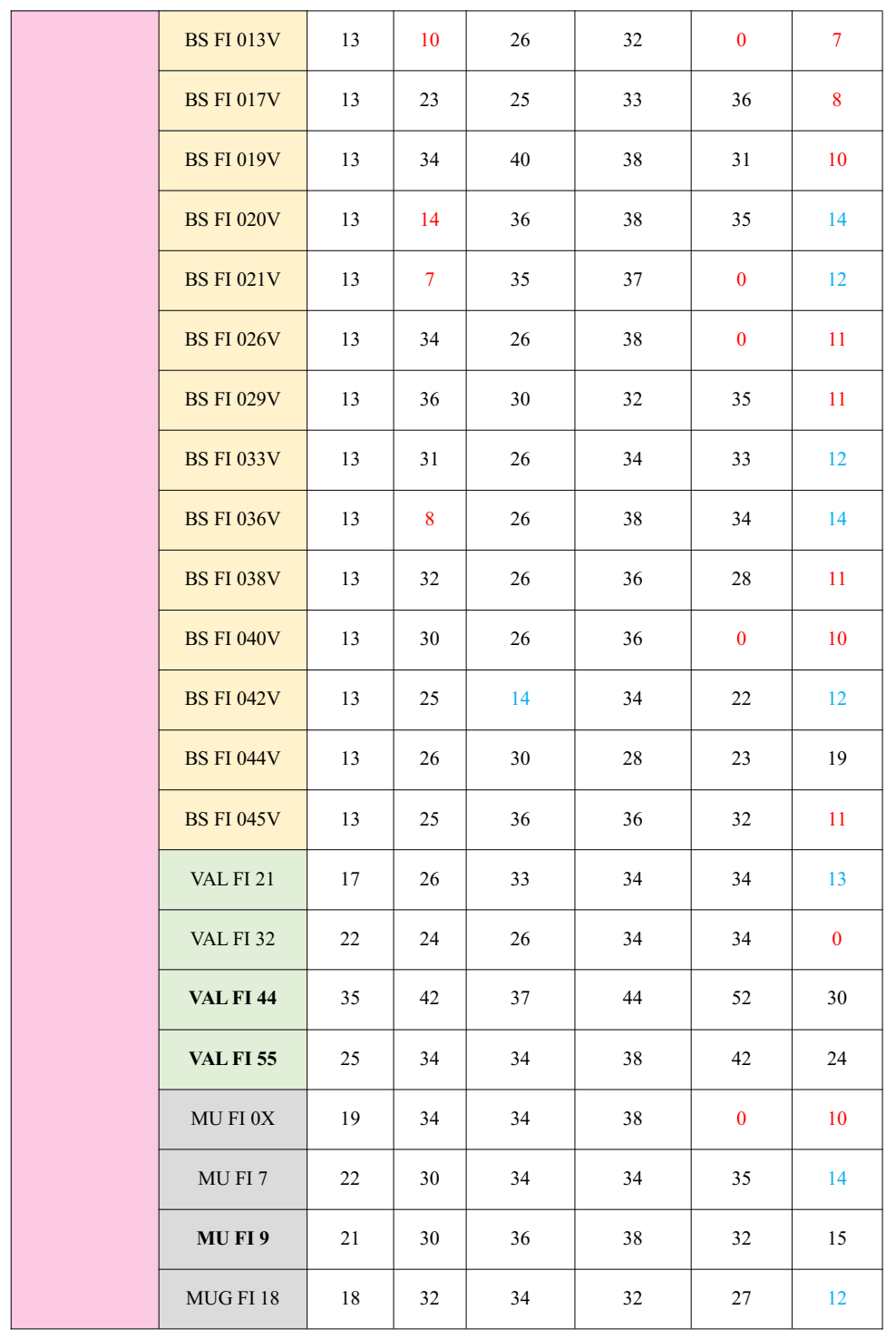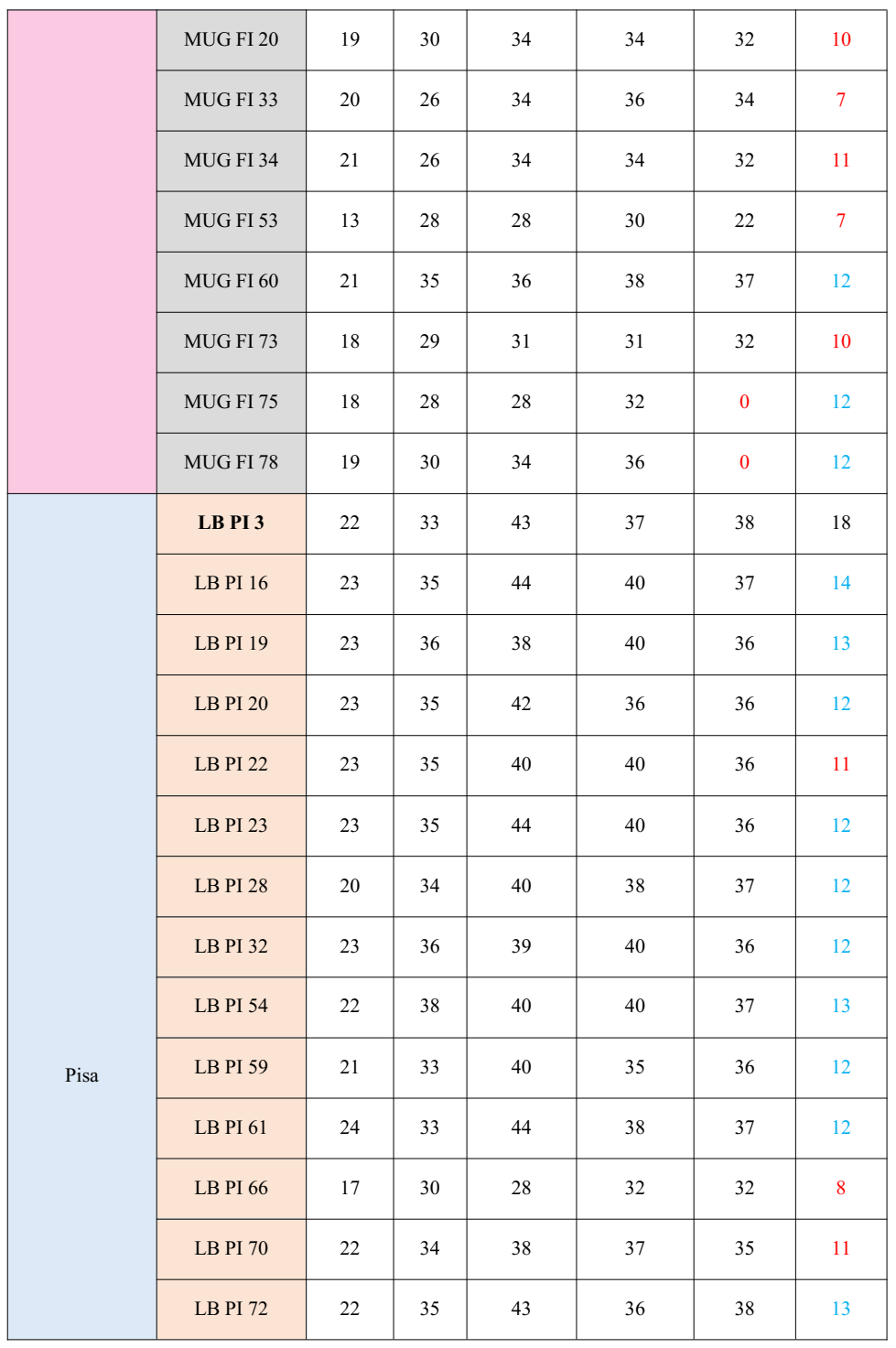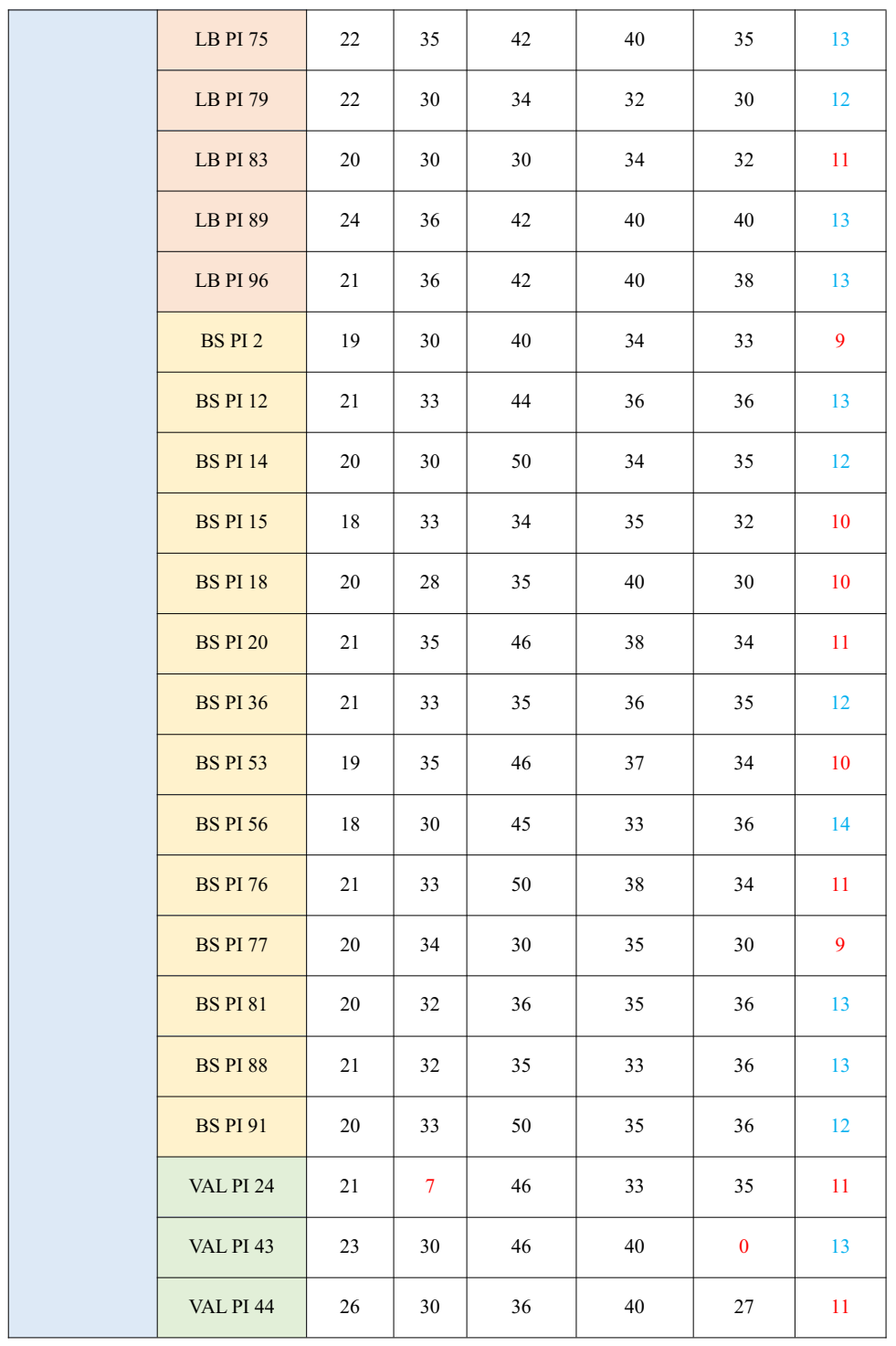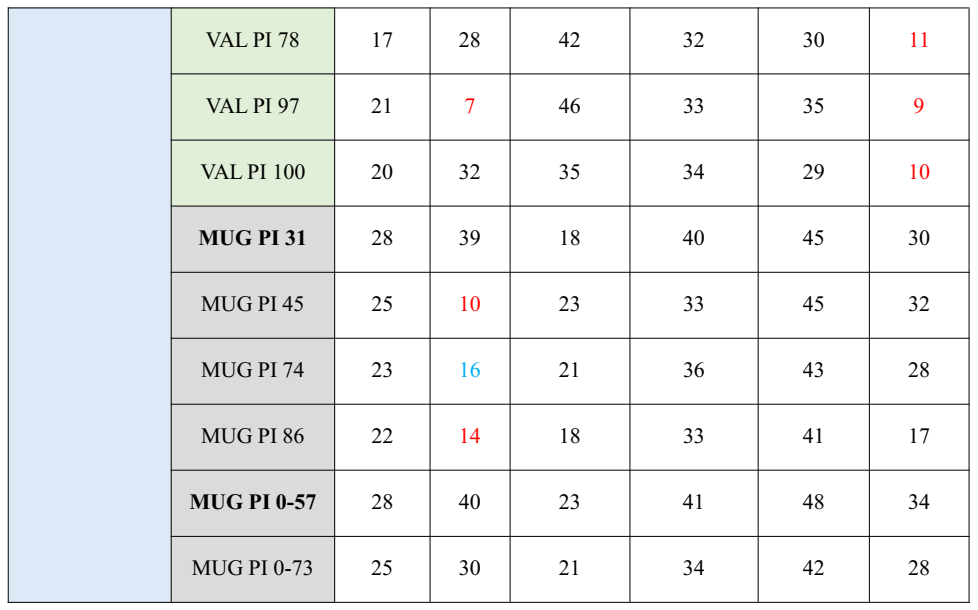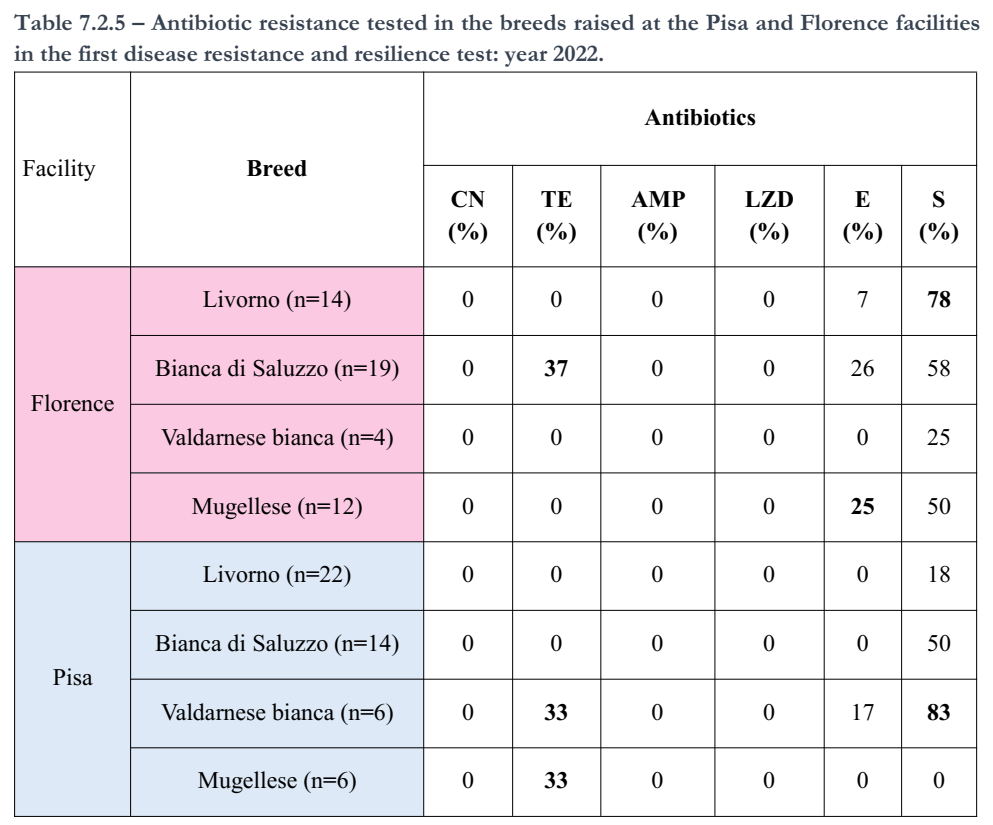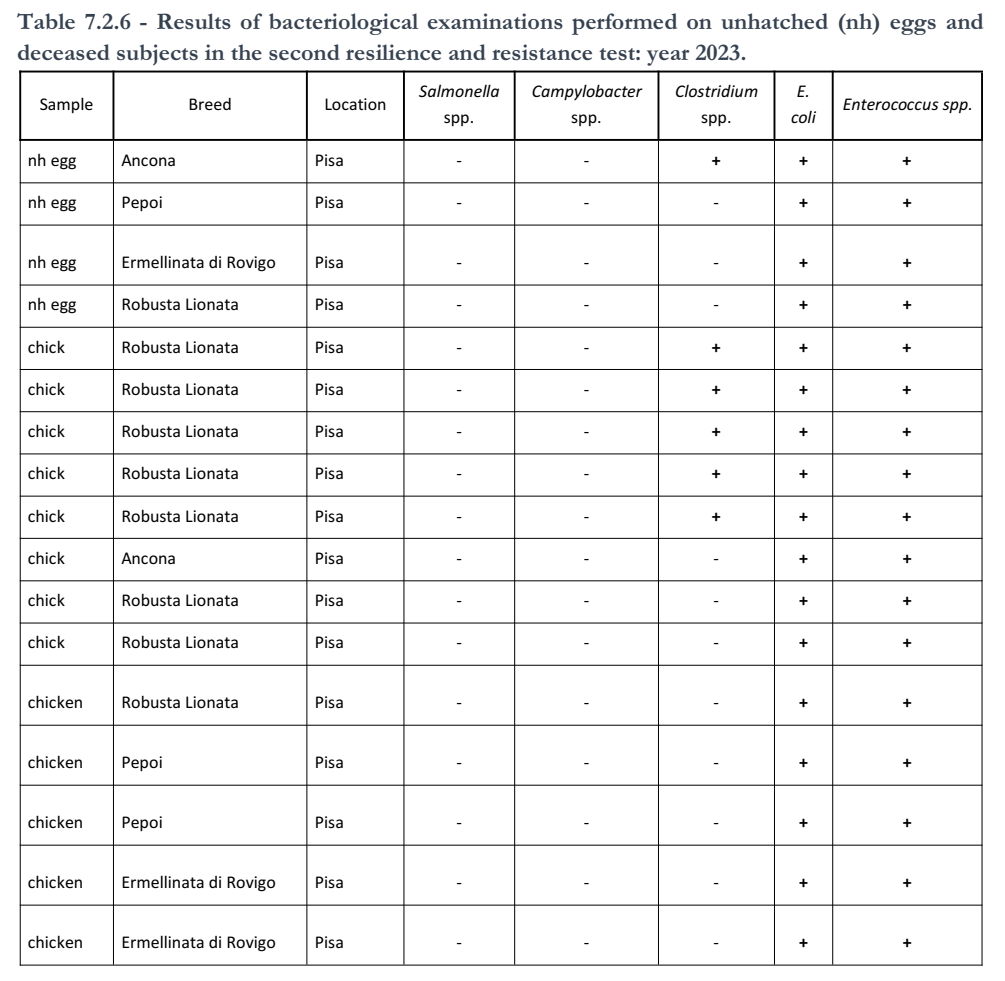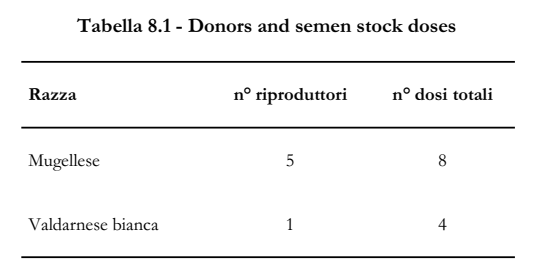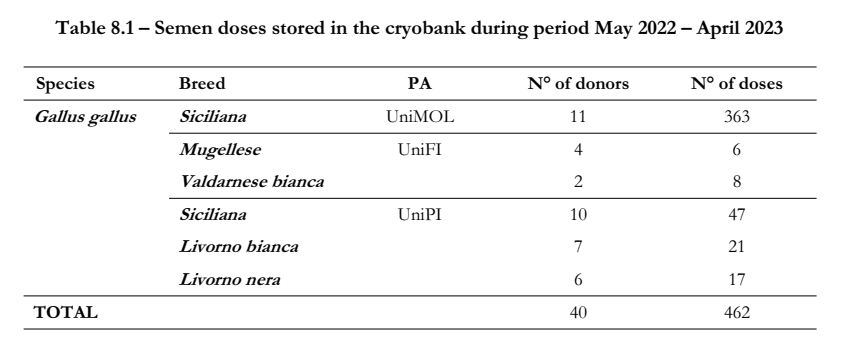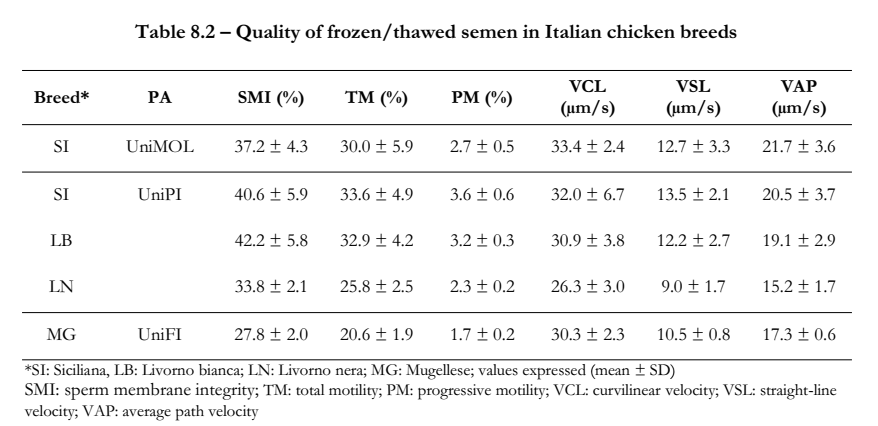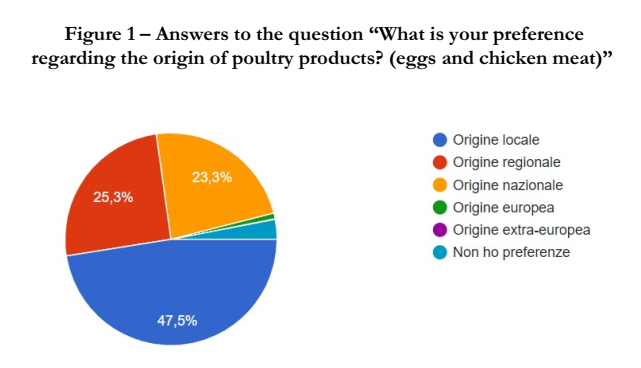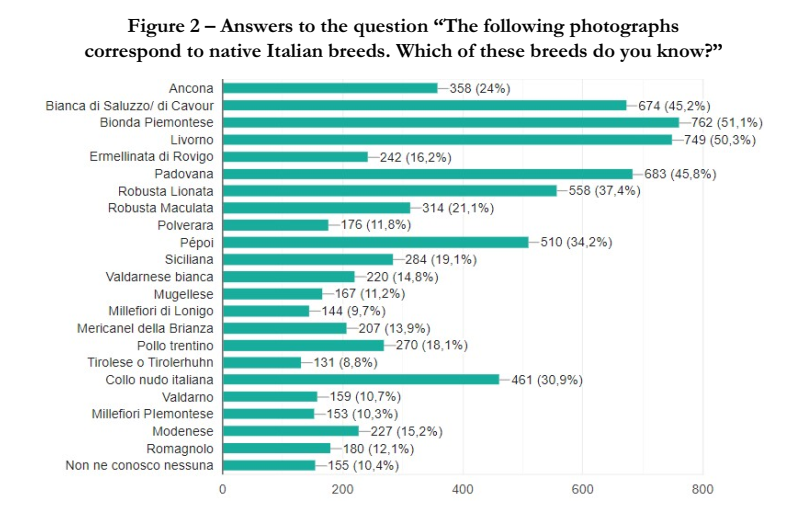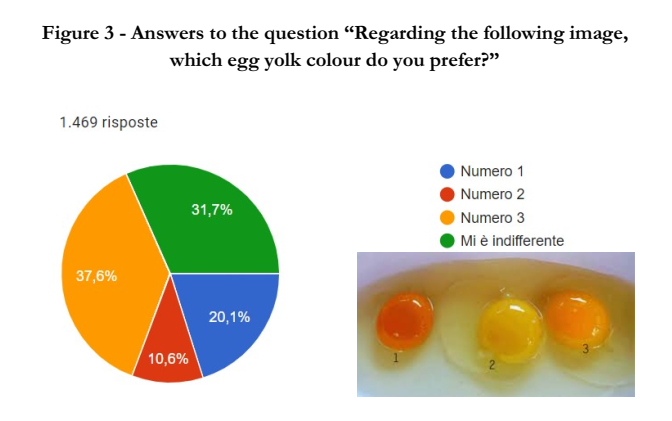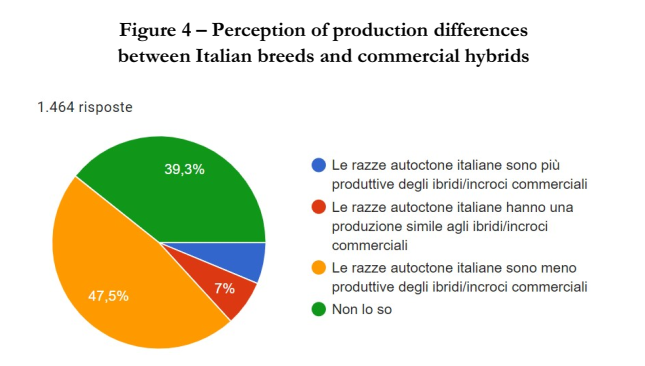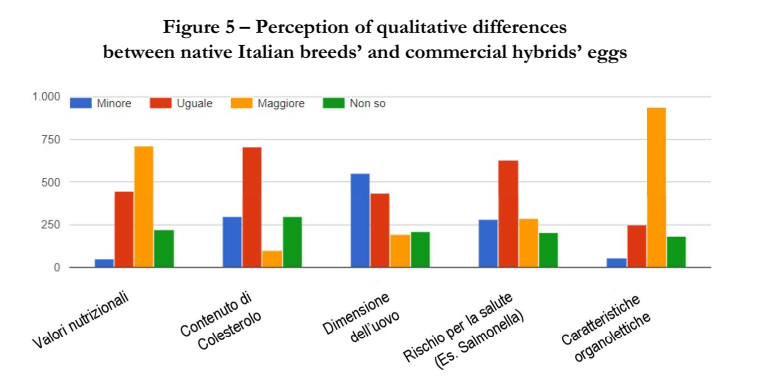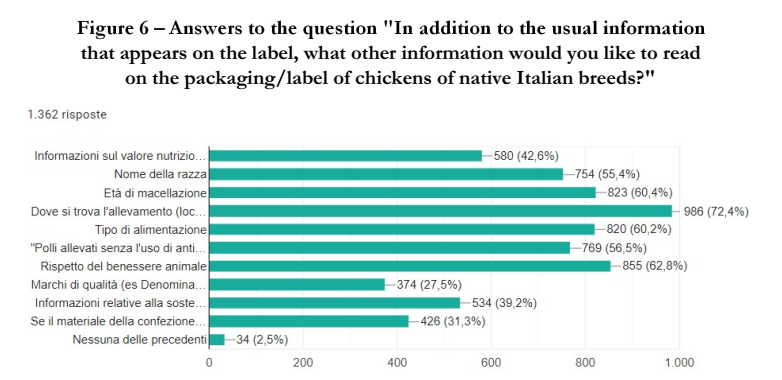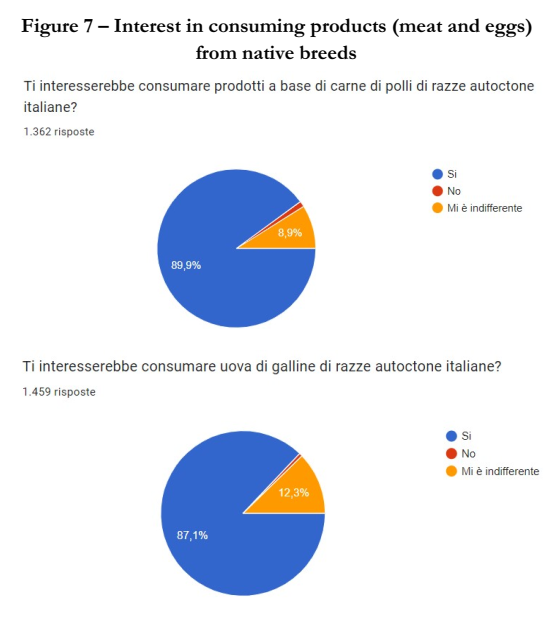Action 1 – Phenotypic characterisation
University of Milan
Phenotipic characterization of Mericanel della Brianza (MB) chickens Rearing activities related to the Mericanel della Brianza nucleus population continued during the second year of the project. Chickens hatched in March-April 2022 (n=138) were reared in order to select young breeders. Chickens were marked and weighted on hatch and reared in floor pens with controlled environment up to 225 days of age. The growth curve of both sexes is reported in Figure 1.1. All males (n=61) were sampled (feathers) and genotyped (external service UniTO) in order to set the mating plan according to molecular kinship and individual heterozygosis index. Selected breeders were organized in 4 familiar lines (A, BC, DEF, G), with the loss of 3 lines compared to the previous year. Each familiar line included 1 male and 10-12 females, and was reared in a floor pen with controlled environment. Sexual maturity occurred at 24-26 weeks of age (September-October 2022).
A small population of MB birds (20 males + 20 females) was introduced on November 2022 at the Poultry Center to identify new familiar lines. A quarantine period was observed to run sanitary tests and assess morphological traits; 26 birds were selected for genotyping. The results of genetic analysis provided 2 new familiar lines (5, 6) and a mating plan for all lines, including both males hatched at the Center and new ones.
Composition and characteristics of familiar lines in reproduction from February to May 2023 are reported in Table 1.1. Egg production and weight was recorded from September 2022 to May 2023. Weekly oviposition rate (%) is shown in Figure 1.2. Overall mean egg weight was 38,5 g (SD=3,64 g), and the range recorded in the period October 2022-May 2023 was 31,4 – 34,5 g.
So far, eggs have been set twice in order to select young breeders. Fertility and hatchability are reported in Table 1.2. Large variability was observed in fertility and hatchability according to the familiar line (Table 1.3).
Phenotipic characterization of Modenese (MO) chickens Thirty days old MO chickens (n=10) were housed at the Poultry Center (UniMI, Lodi) on July 2022. A quarantine period was observed to run sanitary tests. Body weight was recorded in 8 birds, 2 females and 6 males, and the growth curve is reported in Figure 1.3. Consistent reproductive data were not collected, since only one couple was available for reproduction. Further female Modenese hens have to be introduced to organize several familiar goups, as it is required for the phenotypical characterization of the breed.
Phenotipic characterization of Nero d’Italia (NI) and Brianzolo (Br) turkeys
BR breed – Eleven week old BR turkeys (n=10) were housed at the Poultry Center on July 2022. A quarantine period was observed to run sanitary tests and 6 turkeys (3 males + 3 females) were kept for the reproductive period. Turkeys were organized in couples and reared in floor pens with controlled environment. Body weight was recorded at 14, 30 and 47 weeks of age; mean body weight of males and females is shown in Table 1.4. Sexual maturity in female turkeys occurred on 27 weeks af age; the weekly oviposition rate (%) recorded from October 2022 to May 2023 is shown in Figure 1.4. Overall mean egg weight was 69 g (SD=5,9 g), egg weight progressively increased from 64 g to 76 g in the period November 2022 – May 2023. Egg settings have been planned in May and June to hacth the progeny for young breeder selection.
NI breed – The search for NI turkeys has continued all the second year long; young turkeys are planned to be housed at the Poultry Center on next July 2023.
Phenotipic characterization of semen in chicken and turkey breeds Laboratory analyses were performed to assess the proteomic and lipid profiles of sperm and seminal plasma (previously stored samples) in the following breeds: Bionda piemontese (BP), Bianca di Saluzzo (BS), Pepoi (Pe) and Robusta maculata (RM). Furthermore, semen production and quality were recorded in Ermellinata di Rovigo (ER) and Robusta lionata (RL) chicken breed.
Proteome – Sperm and seminal plasma samples were analysed by mass-spectrometry using a shot-gun proteomic approach. Protein mixture was extracted from the samples, prepared, digested with trypsin and then analysed using nano-LC-MS/MS spectrometry (Orbitrap Fusion Tribrid, Thermo Fisher Scientific). Raw data were analysed using MaxQuant software (versione 1.6.1.0) for identification and quantification of proteins in each dataset.
The preliminary analysis allowed to identify datasets (4 for each breed) that underwent differential expression analysis (Table 1.5, Table 1.6) aimed to identify shared and exclusive proteins of the different chicken breeds (Figure 1.5, Figure 1.6). The same proteins will be used in the next functional informatic analysis.
Lipids – Total lipids were extracted according to the Folch method and separated with TLC procedure in the following classes: total phospholipids, triacylglycerols, free fatty acids, cholesteryl ester. Esterified lipid classes were transmethylated by refluxing and the fatty acid composition determined by GC with FID detector on capillary column. Free cholesterol was quantified using a commercial kit. Analysis of raw data and statistical analyses are in progress.
Semen production and quality – Roosters of ER (n=20) and RL (n=20) breed were housed in single cages with controlled environment at the Poultry Center. Birds were trained to semen collection, then routinely milked twice weekly from February to May 2023. Mean values of semen quality parameters are reported for each breed in Table 1.7. After centrifugation, sperm and seminal plasma aliquots were stored at -20°C for further proteomic and lipid analyses.
University of Florence
Phenotypic characterization of chickens of the Mugellese, Valdarnese Bianca and Valdarno breeds The breeders of the Mugellese, Valdarnese Bianca and Valdarno breeds were bred at the Experimental Farms of the Department of Agricultural, Food, Environmental and Forestry Sciences and Technologies (University of Florence). The breeders, divided into 3 families by breed and livery, were raised on the ground, in separate boxes on permanent litter. All subjects were bred in compliance with the guidelines of poultry farming and the regulations in force on animal welfare.
Characterization of the breeds:
- Morphological characterization, according to the FAO guidelines, 2012 for updating and validating what was collected during the TuBAvI 1 Project for the Mugellese (Mannelli et al., 2023; Figure1) and Valdarnese bianca breeds and first characterization of the Valdarno breed (the data is being processed);
- Weight gains (for the Mugellese breed shown in Figure2, Mannelli et al., 2023) and feed consumption and calculation of the feed conversion index (for the Mugellese breed shown in Figure1.3, Mannelli et al., 2023; for the other breeds the data is being processed) for the growing animals of the 3 breeds protected by the PA UniFI and the evaluation of food consumption with reference to the production of eggs in the families formed for the purposes of the project;
- Daily egg production (for the Mugellese breed reported in Figure4, Mannelli et al., 2023; for the Valdarnese bianca breed reported in Figure1.5)
The data reported in the figures relating to the Mugellese breed and published in Mannelli et al., 2023 are being validated through further data collections.
Phenotypic characterization of chickens of the Mugellese and Valdarnese breeds During 2022, a selection program was set up for the progeny belonging to the nucleuses at UniFI for the Mugellese and Valdarnese breeds, also involving breeders in the Tuscan territory for the enhancement of the breeds and to set up joint mating plans.
Phenotypic characterization of chickens of the Valdarno breed The subjects of the Valdarno breed at the UniFI experimental farms showed serious problems of consanguinity and susceptibility to thermal stress and in contracting diseases. Therefore, while awaiting the mating plans of the Project, the most resistant subjects were chosen, showing the best phenotypes for the subsequent matings, and 2 families were established with 1 male and 3 females each. To date, the progeny of these two families is in the growth phase and is being monitored for phenotypic characterization.
University of Padua
During the second year of activities of the project, the sampling of biological material (blood) and the recording of phenotypic characteristics have been completed for animals belonging to Faraona Camosciata (n = 51), Anatra Mignon (n = 55), and Anatra Germanata Veneta (n = 55) species/breeds.
As regards species/breeds for which difficulties in retrieving animals were encountered during the first year of activities due to very small population size, only 9 individuals of Oca Padovana breed have been sampled (blood collection and phenotypic characterization) so far. Overall, animals belonging to this breed are weak and with impaired reproductive performances, likely because of the high inbreeding level related to the very low population size. Despite this and outbreaks of avian flu which have further slowed down the sampling due to restrictions on access to the conservation centres/farms, the PA UniPD has planned to complete blood samples collection and recoding of phenotypes on Oca Padovana and Collo Nudo Italiana breeds in June 2023 (for Oca Padovana breed the final sample size is still uncertain because the breed is at risk of extinction).
Table 1 summarises the 2 qualitative phenotypic traits (shank colour and skin colour) recorded on males and females of Faraona Camosciata, Anatra Mignon, Anatra Germanata Veneta e Oca Padovana breeds, and Figure 1 depicts the descriptive statistics (mean and standard deviation) of the 6 quantitative phenotypic traits (live body weight, body length, shank length, shank circumference, sternum circumference, wingspan) measured on the same male and female individuals (for the Oca Padovana breed, results are still partial) (FAO 2012, Phenotypic characterization of animal genetic resources. FAO Animal Production and Health Guidelines).
University of Perugia
Phenotypical characterisation of Ancona and Leghorn breeds Currently, at the Experimental Poultry Centre of the University of Perugia, the native Italian breeds Ancona and Leghorn (White, Black, Golden, and Silver) are preserved, since 2021 the Robusta Maculata breed has also been introduced. Each breed is divided into two families, each family is composed of 12-15 females and at least 3 males. For each family: eggs have been incubated, the characteristics of oviposition, fertility, hatching, chick viability and mortality have been registered (Table 1).
Monitoring the performances of Ancona and Leghorn breeds In all subjects belonging to the above-described breeds, performance monitoring is carried out during all stages of growth of the animal. In addition, the animals reaching the adult age (34-36 weeks) are subjected to registration of biometric measures (according to FAO guidelines) to monitor the compliance with the breed standards (Table 2, 3, 4 and 5). All animals are individually identified by a CIP that provides information on the animal’s age, sex, parentage, weight, and production parameters.
Genetic characterisation of Ancona and Leghorn breeds The selection of the breeders selected by UNIPG involves the evaluation of phenotypic and genetic characterisation. This activity was carried out in collaboration with PA UniMI (collection of biological material for genetic typing) and UniMOL (collection of semen for the realization of a cryobank). The sampling activity with the UniMOL PA was completed in March 2022 (below the steps of the activity), while with the UniMI PA it was completed in October 2022 and described in more detail in Action 4.
– September 2021 – October 2021 Training of Ancona and Leghorn rooster;
– November 2021 First collection and evaluation of semen in collaboration with UniMOL;
– December 2021- February 2022 selection of male donors and maintenance of semen collection;
– March 2022 Second semen collection. Blood sampling of 10 Leghorn chickens (5 males and 5 females) and 10 subjects of Ancona (5 males and 5 females).
– October 2022 Collection of biological material for the genetic typing to the Ancona and Livorno breeds kept at UniPG.
Phenotypical characterisation of Robusta Maculata breed During 2021, in collaboration with the PA UniPD, the Robusta Maculata breed was introduced at the Experimental Poultry Centre of UniPG. The eggs were incubated during January 2022, with subsequent hatching in February 2022. The characteristics of oviposition (fertility, hatching, chick viability and weaning mortality) were monitored as shown in Table 6. In addition, on reaching adult age (34-36 weeks) the weight of 20 subjects of Robusta Maculata female breed and 20 male subjects was monitored (Table 7). Finally, as for the other breeds, biometric measurements were recorded (in reference to FAO guidelines) in order to monitor compliance with the breed standard (Table 8).
Characterisation of the adaptation to low-input breeding systems and evaluation of the performances of the native breeds Evaluation of the adaptability to extensive farming systems characterized by low-input farming (use of local raw materials, moderate energy and protein intake) and “natural” environmental parameters (temperature, humidity and light) in particular, the ability to adapt to conditions of high temperatures (heat-stress) typical of the summer season has been evaluated.
The eggs of Leghorn and Ancona breeds have been incubated and hatched at Experimental Poultry Centre of UniPG. At 14 weeks of age they were transferred to an outdoor breeding system (external density 10 m2/animal), also as control group, the same number of animals were transferred to an indoor breeding system (10 animals/m2) fed the same diet but without access to the outdoor area. Live weight, ICA and AMG data were collected (Table 9).
During the breeding cycle, the weight gain and the performances relate to the production of eggs have been monitored (Tables 10 and 11), in order to characterize the duration of the productive career in the afore mentioned breeding conditions.
To establish the food consumption of the breeds bred in conventional and free-range systems, feed residue was evaluated weekly and also the degree of use of the pasture was evaluated by the inclusion of 4 enclosures (60 x 60 cm) at a distance of 5 and 10 m from the shelter according to the Lantinga et al. method (2004) (Table 12).
Behavioural characterisation of the Leghorn breed. The study protocol of the following test was submitted and accepted by the University Committee of Bioethics (prot n.76527 of 3/3/2022). The trial involves the use of 46 hens and 6 males of white Leghorn, the housing occurred the first week of June 2022 at 14 weeks of age. The animals were divided into two experimental groups:
- I Group reared indoors: the animals were housed in 3 boxes without outdoor access with a density of 10 animals/m2. In each box 9 females and 1 male were housed for a total of 27 females and 3 males. This experimental group act as the control group.
- II Group with outdoor access: the breeding area is characterised by the presence of three outdoor parks each with a shelter for the animals in which the following densities was used: external 10 m2/head, internal 10 animals/m2, inside each shelter will be placed 2 feeders and 2 drinking troughs. In each pen 9 females and 1 male were housed for a total of 27 females and 3 males.
The trial for the characterization of the Leghorn breed (described in the 1st report) started in June 2022 was completed. In particular, the behavioral observations were carried out during the months of June and July and between September and October 2022, the minimum and maximum temperatures of the day were recorded.
The trial produced a total of 12 h of outdoor recording and 12h of indoor recording using the software Noldus XT.
In addition, the study of kinetic and feeding behaviour was carried out by applying individual devices (bibs) to animals (Figure 1).
The outdoor area and indoor box needed a different number of devices as indicated in Figure 2 (Mancinelli Cartoni et al., 2022): UWB anchors positioned at the antipodes (9 in the outdoor area and 4 in the box); 1 UWB tag, 1 UWB Gateway, 1 Computer for collecting raw files and 10 chips placed on the bibs.
The software used produced a raw report for each animal with a punctual recording of the behavior (Figure 3).
The behaviour of the animal was recorded every 2 seconds, detecting its spatial position within the four quadrants of the area and the Cartesian axis (x, y, z), indicating the peck and the distance covered (Figure 4).
Behavioural characterisation of the Ancona breed The behavioural characterisation of the Ancona breed is in progress, the housing is scheduled for June 2023 and trial will be conducted as described for the Livorno breed.
University of Molise
Phenotypic characterization of a Siciliana breed conservation nucleus Siciliana (SI) breeders were organized into 3 families and raised at the Di Iorio Donato’s farm, which has been previously agreed. All animals were raised outdoors with access to night shelters, following standard guidelines for poultry farming.
Egg production was recorded daily. Figure 1.1 shows the oviposition curve. From the recorded data it is possible to notice a progressive increase in the percentage of egg-laying starting from the last week of March until reaching the peak (73%) in May. After the peak period, the oviposition rate was constant with values close to 60%, then a progressive reduction was observed until it stopped completely. Oviposition was then absent for about five consecutive weeks and resumed from the second half of December. Additionally, the average weight of the eggs was weekly recorded along with the percentage of egg deposition.
The data obtained show a progressive increase in the average weight of the egg, with minimum values of about 49 g and maximum values of 54,5 g; the average weight recorded during the period under consideration was 52,2 g (Figure 1.2).
Three incubations of SI breed eggs were carried out to verify the level of fertility and hatching; the recorded results are shown in Table 1.1. The fertility and hatchability values recorded by family are displayed in Table 1.2. The breeders of families (n. 29) and the donors used for cryobank purposes (n. 11) were subjected to morphometric measurements according to FAO guidelines (2012); the results obtained are reported in Table 1.3.
Evaluation of the productive characteristics of Siciliana breed chickens at a social farm located in Puglia As part of this task, 85 SI breed chicks born during 2022 were raised at a social farm located in Foggia – Apulia region (Cooperativa Emmaus). This farm promotes the preservation of animal biodiversity within a community of social utility and thanks to this project a small rural breeding of SI has been created. The social farm serves as an example of a rural production system that is suitable for local breeds.
Individual live weight, feed conversion ratio and mortality were recorded monthly on male and female subjects. Table 1.4 shows the mean weights expressed as means ± standard deviation starting from the first day up to 180 days. The results obtained are in line with the growth performance recorded in the group maintained during the previous project. The mortality rate recorded up to six months was 2.3%. At 180 day of age, 24 birds (12 birds/sex) were weighed and slaughtered. Carcass and the main cuts weight were recorded. Males had a higher slaughter weight, carcass weight and yield than females; while, a higher breast yield was found in females compared to males (+ 2.9%) (Table 1.5). As part of the activities for the turnover of the SI breed conservation nucleus, 44 individuals (30 females and 14 males) were phenotypically selected. 3-4 intact whole growing feathers were collected from each subject and sent to the Animal Molecular Genetics Laboratory of the University of Turin (consultant for UniMI) for genetic analyses.
Phenotypic characterization of Romagnolo (RO) and Ermellinato di Rovigo (ER) turkeys During 2022, 10 RO and 6 ER turkey breeds were purchased from private farms located in Emilia-Romagna. To increase the number of animals available, from April 2023, incubation activities of fertile eggs of both breeds were started.
Phenotypic characterization of Bianca di Saluzzo chicken breed The activities related to this task will be carried out during the fourth step of the project (year 2024).
Phenotypic characterization for the assessment of innate immunity The objective of the task is to monitor immune resilience on a panel of 7 native breeds of chicken and 2 of turkey by measuring some markers of innate immunity: complement, IgY and lysozyme. During the period May 2022-April 2023 was monitored the innate immunity in 7 chicken breeds: Livorno (LI) and Ancona (AN) – (UniPG); Mugellese (MG) and Valdarnese bianca (VB) – (UniFI); Bionda piemontese (BP) and Bianca di Saluzzo (BS) – (UniTO); Siciliana (SI) – (UniMOL).
For each breed, blood samples were collected from 5 males and 5 females; after coagulation (2 hours at room temperature), the samples were centrifuged at 3000 rpm for 20 minutes, the serum obtained from each subject was aliquoted in 3 or 4 eppendorf and stored at -20 °C. The quantitative analysis of the lysozyme C (LYZ) was carried out by a competitive enzyme immunoassay technique (ELISA kit), while for the determination of the Complement Component 3 (C3) and IgY was used a quantitative sandwich ELISA kit. Subsequently, the optical density was measured by at 450 nm using the ELISA reader Tecan – Infinite® M Nano.
The results obtained are shown in Table 1.6, considering the GLM procedure used to determinate the effects of the considered variables (breed and sex) on the immunological markers evaluated, a significant effect of breed for all considered parameters emerged, while the sex effect was significant for LYZ and C3. Significantly higher values of LYZ (ng/mL) were obtained in males of the BP breed compared to males and females of the all other breeds considered, excepted for males of the BS and LI breeds. Higher values of C3 (µg/mL) were recorded for SI breed and males of BP and BS breeds (p<0.05). Finally, regarding the IgY, the highest concentrations (mg/mL) were obtained for females of SI breed compared to females and males of MG, VB, BS and BP breeds, and male of LI breed (p<0.05). Knowledge of the analysed parameters allows to have preliminary data on the immune status of the breeds considered.
Phenotypic characterization of fresh semen The assessment of fresh semen quality was carried out for the following chicken breeds: SI, Livorno bianca (LB), Livorno nera (LN), MG e VB. The following qualitative-quantitative parameters were evaluated: sperm volume and concentration, cellular membrane integrity (by flow cytometry) sperm total motility, progressive motility, and kinetic parameters (by CASA system with SCA software).
The results obtained from the assessment of fresh semen quality of the native chicken breeds considered are reported in Tables 1.7 and 1.8.
Aliquot of seminal plasma and spermatozoa of the SI breed were prepared and stored at -20°C to evaluate the protein and lipid profile, which will be performed in an integrated manner with the PA UniMI.
University of Pisa
Phenotypic characterization of Livorno, Siciliana, Bianca di Saluzzo, Bionda Piemontese, and Millefiori Piemontese chicken breeds Throughout the designated period, Livorno (L) and Siciliana (S) breed chickens completed their first egg-laying cycle in October 2022 and started the second cycle in January 2023. All birds were raised in open-air enclosures with partial roof coverage, situated on sandy soil, and exposed to natural lighting and temperature conditions at the Poultry Farm of the Department of Veterinary Sciences of the University of Pisa. The daily egg production (Figure 1.1.1), egg weight (Figure 1.1.2), and egg size during the first egg-laying cycle continued to be recorded until the end of September 2022. The evaluation of hens feed consumption as well as FCR-eggs (Table 1.1.1) was conducted until July 2022. In October 2022, family groups were formed for originating the 2023 restocking, according to the mating plan developed by the Animal Molecular Genetics Laboratory at the University of Turin. Nine family groups were established for the L breed (4 for white L, WL, and 5 for black L, BL), and 3 families for the S breed. These groups at the second egg-laying cycle were monitored for daily egg production from January 2023 onwards, and for monthly egg weight and egg size as well as for feed consumption in 14-day intervals (data being processed) from January to June. Reproductive parameters (fertility and embryonic mortality) were assessed through 5 incubations conducted from February to April 2023 (data being processed). Offspring intended for restocking, hatched in April 2023 and are currently being monitored for growth, mortality, and morphometric traits as outlined in the project.
Data from Piemonte breeds Bianca di Saluzzo (BS), Bionda Piemontese (BP), and Millefiori Piemontese (MP), reared at the Center for the Conservation of Local Genetic Resources (Carmagnola, Turin), were collected by UniTO as a consultant for Partner UniPI.
Phenotypic characterization of Ancona (A) breed chickens The monitoring of daily egg production during the first egg-laying cycle continued until the end of September 2022 (Figure 1.2.1). The recording of egg weight was carried out until July (Figure 1.2.2, partial data). In October 2022, three family groups were formed for the 2023 restocking, by following the mating plan developed at the Animal Molecular Genetics Laboratory of the University of Turin. The family groups were monitored from January 2023 for egg production and egg weight during the second egg-laying cycle. Reproductive performance was assessed through six incubations to determine fertility and embryonic mortality levels (data being processed). The restocking nucleus hatched in April 2023, and is being monitored for growth, mortality, and morphometric traits, as planned in the project.
Characterization of laying hens’ adaptation capacity to seasonal environmental stimuli In 2022, the physical and chemical characterization of the yolk and albumen of eggs produced during the first egg-laying cycle for L and S breeds continued until July (Tables 1.3.1 and 1.3.2). At the beginning of 2023, the analysis of eggs resumed to characterize the second year of laying (Table 1.3.3).
University of Turin
Phenotypic Characterization of Bianca di Saluzzo and Bionda Piemontese chickens breeds The breeding roosters of Bianca di Saluzzo (BS) and Bionda Piemontese (BP) chicken breeds, raised at the Center for Conservation of Local Avian Genetic Resources (Interdepartmental Center PRISAn DSV-DISAFA) during 2022, were in their first reproductive cycle. In 2022, the BP breeders (n=80) were organized into 6 family groups, while the BS breeders (n=70) were organized into 5 family lines. Egg production and their weight were recorded daily. The data were processed on a weekly basis and presented in Figures 1.1-1.3.
In this report, it is possible to present the complete deposition curves of both breeds, integrating the previously presented data with those collected in the remaining part of 2022. For both breeds, the peak of egg laying occurred between weeks 33 and 36 of life, reaching a maximum of 77.4% for BS (Figure 1.1) and 74.3% for BP (Figure 1.2). The comparison between the deposition curves of the two breeds is jointly presented in Figure 1.3.
All the chickens were raised on the floor with permanent litter in a controlled environment, following standard guidelines for poultry farming. The recording of egg production and their weight for the second year of production is ongoing and will be the subject of the next report, which will present the complete data for the 2023 laying season.
In the spring of 2022 and 2023, a fertility and hatchability test was carried out for the two established breeds (BP and BS). Additionally, in 2023, 134 eggs were provided from the Millefiori Piemontese (MP) farms, which had been identified and genetically characterized in 2022, to initiate the reconstruction of the conservation nucleus.
Regarding BS, a total of 700 eggs were incubated in 2022 and 594 in 2023. As for BP, a total of 750 eggs were incubated in 2022 and 569 in 2023. Both in 2022 and 2023, incubation was conducted simultaneously to obtain contemporaneous subjects. The hatched chicks in 2022 were used for other purposes, while those hatched in 2023 were used for the internal breedin of BP and BS and the creation of the conservation nucleus for MP.
In Figure 1.4, the comparison of the trend of fertility and hatchability % in the Bianca di Saluzzo breed (during years 2022 and 2023), Bionda Piemontese breed (during years 2022 and 2023), and Millefiori Piemontese breed (during year 2023) is shown. Currently, phenotypic observations and growth measurements are being conducted for the three Piedmontese poultry breeds. The technical and scientific value of the 2023 data is significant, as it represents the first rigorously collected data for the MP breed. Figure 1.5 shows one-day-old chicks of Millefiori Piemontese breed.
Activities within Action 1 are performed as a consultant for Partner UniPI.
Action 2 – Genetic characterisation
University of Milan
Sequencing of genome in Meleagris gallopavo species The sample for genomic analyses included the following breeds (n. birds): Castano precoce (8), Bronzato comune (7), Ermellinato di Rovigo (7), Romagnolo (9), Tacchino di PR&PC (6). DNA samples were extracted and sent to Novogene lab (Novogene, Company Limited, UK) after quality control for sequencing and bioinformatic analyses. Data were provided on May 2023 and statistical analyses are in progress.
University of Padua
The genetic analyses will be conducted by an external service and will be performed between June and December 2023. These analyses will focus on DNA extraction from individual blood samples (about 2 mL) collected the same day of phenotyping of animals for qualitative and quantitative characteristics. Blood samples have been added with EDTA at sampling and currently they are stored in tubes at -20°C, awaiting the shipping to the external service (through blood-cards) for the genotyping using SNP molecular markers. After careful review of the scientific literature, the genetic characterization will be performed according to the following approaches:
- for the Collo Nudo Italiana and Millefiori Piemontese breeds (Gallus gallus), the Affymetrix Axiom Chicken 600K HD chip will be used;
- for the Anatra Mignon and Anatra Germanata Veneta breeds (Anas platyrhynchos), low-coverage whole genome sequencing will be used (4X coverage);
- for the Oca Padovana breed (Anser anser), low-coverage whole genome sequencing will be used (4X coverage);
- for the Faraona Camosciata breed (Numida meleagris), low-coverage whole genome sequencing will be used (4X coverage).
University of Perugia
Genetic characterisation of native chicken breeds through the study of polymorphisms in candidate genes involved in heat stress response The sampling of biological material from breeds reared at the experimental section of UNIPG as described in Table 13. An aliquot of each of the 115 samples was sent to UNIMI on 30th October 2022 for the study with markers microsatellites that will provide guidelines for the programming of couplings in the UNIPG experimental centre for proper safeguard of breeds, avoiding consanguinity and identifying the best breeders. In addition, the aforementioned samples together with the dataset of TuBAvI I and with the addition of the samples of the breeds Millefiori Piemontese and Collo Nudo Italiana, will be part of the dataset that will be subjected to the study of polymorphisms in genes belonging to the HSP family.
DNA extraction is ongoing for new biological samples taken at the experimental section of UniPG. In the coming months all the samples of the final dataset for the genotyping of HSP will be sent.
University of Turin
Genetic characterization using microsatellite markers Genetic characterization with microsatellite markers is designed to provide useful tools for biodiversity conservation in nucleus populations managed by the PA and in the semen cryobank. In particular, the following objectives are considered: 1) identifying candidate males for recovery and semen production; 2) characterizing new genetic lines in breeds under conservation; 3) characterizing new chicken breeds.
Characterization of male candidates For recovery and management plans, the candidates present in the UniPG conservation nuclei belonging to 5 populations (Ancona, Livorno in golden, silver, white, and black colorations) have been characterized. The candidates present in the UniFI conservation nuclei and the offspring of the UniMOL conservation nucleus are currently being characterized.
Identification of new genetic lines in chicken breeds LI, AN, MB and SI As part of the identification of new genetic lines, 26 individuals belonging to the Mericanel della Brianza breed, 17 females and 9 males, from local farms were genetically characterised.
The observed average heterozygosity (Ho=0.48) was analyzed as an estimate of inbreeding, as shown in the Figure 2.1, along with the median, standard deviation (SD), standard error (SE), maximum, and minimum values. The Hardy-Weinberg equilibrium test shows a significant deviation from equilibrium only at certain loci.
The overall distribution is discontinuous, although the mean and median values are very similar; individuals with high homozygosity (Ho<0.30) and low values of individual variability, indicating inbreeding, can be observed.
Principal component analysis highlights the existing genetic variability in the sampled group (Figure 2.2). The graph illustrates the distribution of subjects in terms of genetic diversity (subjects with higher similarity are closer in the graph, while genetically distant ones are farther apart). Based on genetic distance evaluations, females can be grouped into 2 families (Figure 2).
The genetic variability of the analyzed subjects was compared with that of the subjects present in the conservation nucleus (Figure 2.3). The analysis of allele patterns (Figure 2.4) also reveals the presence of private alleles in the sampled family (27 private alleles).
Action 4 – Genetic indexes and mating plans
University of Florence
The subjects of the Mugellese breed were sampled (as per the project timetable) for genetic characterization for the purpose of mating plans. Feathers were collected from a total of 50 subjects belonging to UniFI and 5 other farmers in the area.
University of Turin
Selection of males for reproduction and production of seminal material The typing data were used to calculate the parentage matrix by assessing the number of shared alleles for each pair of individuals belonging to the same breed. The average kinship between all breeders (P) and the average kinship with family lines (Pf) were calculated. Individual heterozygosity (H-ind) was calculated for each subject.
Reproductive Management For the Mericanel breed, new genetic lines identified in the territory were introduced in reproductive management. The individual variability index (H-ind) and the average kinship index (P) were estimated for the mating plans with all the analyzed subjects. Males with higher H-ind values allow for the preservation of greater genetic variability, while those with lower P values help contain inbreeding. Based on the results of the genetic analyses, females have formed the new families 5 and 6 of the conservation nucleus. Mating was carried out by calculating the average kinship of the genotyped males with the subjects of each family present in the nucleus (1 to 4) and with the 2 identified families (5-6) (Figure 4.1).
Furthermore, the kinship indices of the two new families with the males present in the conservation nucleus were also calculated (Figure 4.2).
The selection of breeders was made to cover the maximum existing variability while considering individual heterozygosity. Mating was planned between subjects belonging to different bloodlines to minimize the relationship between the males and the female groups. The average kinship between the female groups and the selected male was calculated for each male to minimize the rate of inbreeding (∆F). The results of the analysis were reported in the genetic evaluation document sent to the UniMI coordinator and the relevant PA.
For the populations present in the UniPG conservation nucleus, the 5 populations (Ancona, Livorno in golden, silver, white, and black colorations) were analyzed. For these populations, the bloodlines were identified by also typing the females, and the subjects belonging to each genetic line were defined. To identify genetically similar subjects from the parentage matrix, the distance matrix between individuals was calculated. To maintain maximum genetic variability, females from each family belonging to the same genetic line were grouped together in the same family group and bred with genetically distant males.
Activities within Action 4 were perfomed as a consultant for Partner UniMI.
Action 7 – Genetic resistance traits
University of Florence
In this action, UniFI, in collaboration with UniPI, began the evaluation of the resilience and resistance to pathologies and environmental stresses of the Mugellese, Valdarnese bianca, Livorno and Bianca di Saluzzo breeds in terms of animal welfare and resistance to pathogens, using the response of the intestinal microbiota to environmental stimuli as an information marker.
The subjects belonging to these breeds were bred in free-range and fed with the same feed (Monge) at our UniFI headquarters and at the UniPI headquarters, according to the same scheme. At the end of the test, the caecal feces of each test subject were taken from both sites. DNA was extracted from the collected samples and sent to the IGA company for sequencing. We are in the process of processing data received from IGA.
University of Pisa
Evaluation of resilience for growth under environmental stimuli The growth trial on the Bianca di Saluzzo (BS), Valdarnese (VAL), Mugellese (MUG), and white L (WL) breeds was completed in September 2022, when birds were 180 days old. Birds were reared at the facilities of Pisa University as well as at Florence University. Weights and average gains per breed are presented in Figure 7.1.1.; feed consumption and FCR (Table 7.1.2) and mortality (Table 7.1.3) data are reported for each group within the different breeds.
In February 2023, a new growth trial started and eggs from Ancona (A) breed, coming from Pisa University poultry farm, and eggs from Robusta Lionata (RL), Ermellinata di Rovigo (ER), Pepoi (PP), coming from the Experimental Conservation Center in Ceregnano (Rovigo, Italy), were incubated at the facilities of Pisa and Florence Universities. The incubation results, from Pisa’s data, are shown in Table 7.1.4. In March 2023, chicks hatched and were raised in cages within a protected environment until they reached the suitable age for outdoor transfer. Data collection for live weight, feed consumption (data being processed), and mortality (Table 7.1.5, partial data) is currently underway.
Evaluation of resistance/resilience to bacterial and parasitic infections/infestations and resilience of intestinal microbiota Fecal samples were collected from the 2022 and 2023 growing chicks monitored as previousy described, as well as from the coeval chicks raised at the Florence University facility, which collaborates in the research. These samples were used for qualitative and quantitative parasitological analyses, including the detection of coccidia (Eimeria spp.), nematodes (ascarids, capillaries, Heterakis spp.), protozoa (Giardia spp. and Cryptosporidium spp.), and Histomonas meleagridis. The results of the 2022 evaluations are presented in Table 7.2.1, and the partial results of 2023 evaluations are shown in Table 7.2.2.
Regarding the 2022 trial, four cloacal swabs were collected per 120-day-old-bird from Pisa and Florence facilities to detect pathogens such as Salmonella spp., Clostridium perfringens, Campylobacter jejuni (all samples tested negative), and commensal bacteria such as Enterococcus spp. (Table 7.2.3), Lactobacillus spp., and Bifidobacterium spp. The isolated strains were evaluated for antibiotic resistance profiles (Tables 7.2.4 and 7.2.5). The results of the examinations for the presence of pathogens on unhatched eggs in 2023 and on deceased subjects are reported in Table 7.2.6.
Action 8 – Germplasm collection
University of Milan
Collection of germplasm for the Semen Cryobank The Italian semen cryobank of autochthonous chicken and turkey breeds was implemented and semen collected from the breeds described in Action 1 was stored in liquid nitrogen. Semen doses were prepared according to the cryopreservation procedure for chicken semen described in the Cryobank SOPs. Seven male semen donors were selected according to semen production (both quantity and quality variables) in both Ermellinata di Rovigo and Robusta Lionata. The preparation and storage of semen doses is still running and will end in June. At present, 158 and 35 semen doses have been stored for ER and RL breed respectively.
University of Florence
Germplasm collection in the Semen Cryobank of Italian Poultry Breeds The activity carried out involved the implementation of the SOPs of the Italian Poultry Breed Semen Cryobank for the storage of germplasm of different donors of different breeds in the Gallus gallus species. In particular, in Table 8.1 shows the number of donors and sperm doses stored in the cryobank during the first year.
University of Molise
Germplasm collection in the Semen Cryobank of Italian Poultry Breeds During the reference period the Cryobank of the Semen of Italian Poultry Breeds was implemented with semen doses of the chicken breeds indicated in Action 1. The seminal material was frozen using the procedure described in the cryobank SOP for the Gallus gallus species. The number of donors and semen doses stored for each breed is reported in Table 8.1. Semen quality was also evaluated after the freezing/thawing process and the preliminary data obtained are reported in the table 8.2.
University of Pisa
The ongoing collection of genetic material from Livorno breed is being carried out in the region due to the outbreaks of avian influenza that have affected Tuscany, thereby impeding access to the relevant farms.
In 2022, the training of Livorno and Siciliana males for semen donation continued till the end of May when the second sampling was conducted for the purposes of the cryobank. The semen was analyzed and frozen by the PA UniMOL. The semen collection process involved 23 L and 11 S roosters, with a positive response rate of 100% for white L, 38% for black L, and 91% for S.
Action 10 – Communication and dissemination activities
During the second year, several actions were performed in order to maximise the efficacy of cummunication and dissemination of the project’s activities and results.
Production of technical data sheets for poultry breeds. Technical data sheets for each of the chicken breeds conserved at the conservation centres of TuBAvI-2 project were prepared and filled in. The data sheets have been published on this website on the pages dedicated to each chicken breed, that can be accessed from the page Breeds.
Production of scientific reports, publication of articles on international thematic journals, presentation of results in national and international thematic conferences. Project’s results were collected and described for dissemination purposes on this same website page. The main results were published on international refereed thematic journals and were presented as posters or in oral communications in several national and international thematic conferences. Published articles and conference posters/presentations can be consulted from the page Publications.
Dissemination of project activities and promotion of autochtonous poultry breed farming During the second year, TuBAvI-2 project participated in many poultry fairs and in dissemination events, as shown in the page Events.
Online survey on the level of consumer knowledge on Italian breed farming and on their products An anonymous online survey (Google Forms) was distributed among Italian citizens, via social media, e-mail, and personal contacts, during the year 2022. The aim was to investigate the recent preferences of consumers about eggs and chicken meat, as well as their knowledge of the Italian poultry heritage. A total of 1,491 people completed the questionnaire. Respondents are mainly women, and the majority of them fall between 26-35 and 46-55 years of age. The section dedicated to poultry farming notions aimed to preliminarily assess the respondents’ average background. Most of interviewees, despite living in cities, demonstrated some knowledge of the agricultural/livestock sector (64.4%) and most of them (81.4%) are aware of the existence of animals specifically selected to produce meat or eggs in intensive farming systems.
The majority of respondents (47.5%) attributes great importance to the origin of the poultry products they purchase, preferring products of “local” origin (Figure 1). Through a photographic list of the main Italian chicken breeds, the interviewees were asked to select the ones they were familiar with (Figure 2). The results not only demonstrate a moderate knowledge of the main native poultry breeds, but also that the most known breeds are the Bionda Piemontese (51.3%), the Livorno (50.1%) and the Padovana (45.8%), while the least known are the Millefiori di Lonigo and the Tirolese (or Tirolerhun). The respondents that stated that they did not know any breed amounted to 10.5%.
Regarding the “Purchasing habits” and “Consumption of meat and eggs” sections, the main place of purchase appears to be the supermarket. In the egg section, although the color of the shell is not generally considered an important purchasing parameter, some of the interviewees (37.6%) still have a predilection for yolks with a medium-intense color (Figure 3). In both “eggs” and “meat” sections, consumers stated that there are differences between products derived from commercial chickens and those from Italian breeds, specifically from a nutritional and organoleptic point of view, attributing greater benefits to products from autochthonous breeds. This indicates a great interest in consuming meat and eggs from Italian breeds (Figure 4 and Figure 5). A further multiple-choice question (both in “meat” and “egg” sections) asked to indicate some potentially interesting claims, that are currently absent on the packaging/label of poultry products, such as the “breed” (selected by almost half of the interviewees). The overall responses suggest the need for more information on the commercial poultry supply chain, such as the farm location, the type of feed used and the animal welfare policies (Figure 6). These results demonstrate the growing curiosity of Italian consumers on poultry products from native breeds (almost the 90% is interested), as well as their interest in supporting the Italian poultry heritage (Figure 7). In fact, more than half of interviewed people said they would be willing to pay higher prices for these products. It is therefore of primary importance to protect native breeds, by supporting and enhancing a potential production chain, thus preventing the disappearance of such a historical and genetic heritage.
